#Qingming Festival/清明節
Explore tagged Tumblr posts
Photo


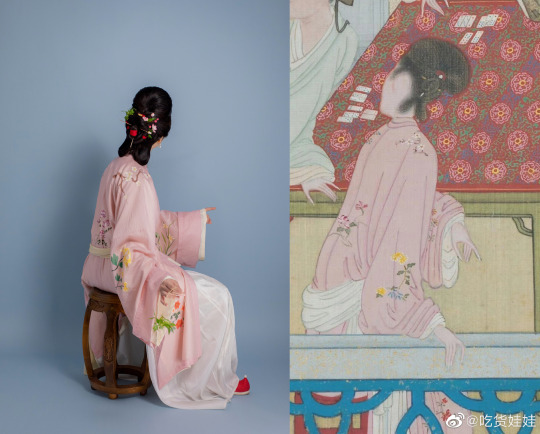
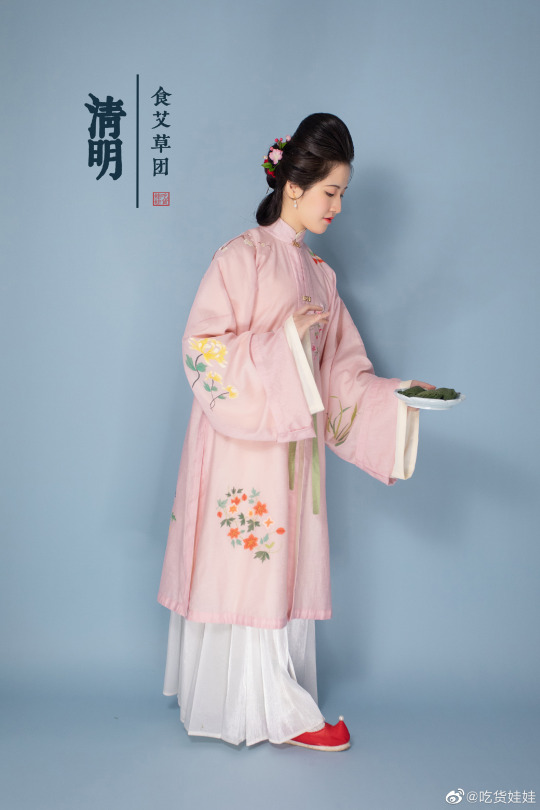



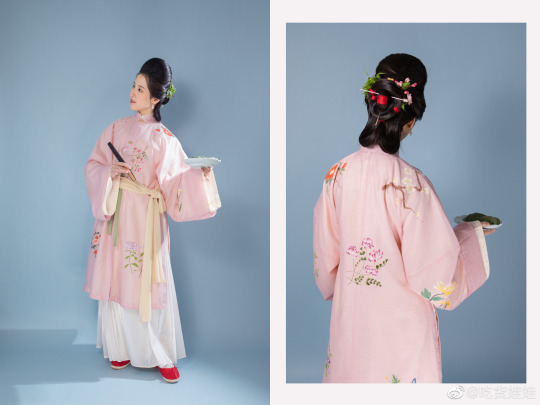

[Hanfu · 漢服]Chinese Early Qing Dynasty Traditional Clothing & Qingming Festival/清明節
————————
Han ethnic Women's attire & Hairstyle ”Peony Head (牡丹头) in the Early Qing Dynasty
Han ethnic Women's attire and hairstyle in the early Qing Dynasty was not like men that force to change by the Qing government. Women's attire and hairstyle were not particularly different from late Ming Dynasty.
————————
【Qingming Festival/清明節】
The Qingming festival or Ching Ming Festival,also known as Tomb-Sweeping Day in English (sometimes also called Chinese Memorial Day, Ancestors' Day, the Clear Brightness Festival, or the Pure Brightness Festival), is a traditional Chinese festival observed by ethnic Chinese in mainland China, Hong Kong, Macau, Taiwan, Malaysia, Singapore, Cambodia, Indonesia, Philippines, Thailand, and Vietnam.
During Qingming, Chinese families visit the tombs of their ancestors to clean the gravesites and make ritual offerings to their ancestors. Offerings would typically include traditional food dishes and the burning of joss sticks and joss paper.The holiday recognizes the traditional reverence of one's ancestors in Chinese culture.
The origins of the Qingming Festival go back more than 2500 years, although the observance has changed significantly. It became a public holiday in mainland China in 2008, where it is associated with the consumption of qingtuan,green dumplings made of glutinous rice and Chinese mugwort or barley grass.
--------
【Qingming Festival Customs: 插柳/戴柳 put willow/wearing willow 】
“清明不插柳,红颜变皓首”:
As the saying goes, it means in Qingming Festival, in the first ten days of March of the lunisolar calendar every year, is the day when traditional customs go to graves to worship ancestors. According to the old custom, when returning from worshiping ancestors during the Qingming Festival, people have to break off willow branches and wear them on head.It is said that if people don’t do this, young people will become old people with white hair.
According to the "Qing Jialu/清嘉录" written by Gu Lu of the Qing Dynasty:
「清明日,滿街叫賣楊柳,人家買之插於門上,農人以插柳日晴雨佔水旱,若雨,主水。」
every Qingming Festival, "willows are sold all over the street, and people buy them and put them on the door.
Q:why wearing willow or put willow on the door?
Jia Sixie(贾思勰)of the Northern Wei Dynasty(386-535) said in "Qi Min Yao Shu/齐民要术": “取柳枝著户上,百鬼不入家。”
“Take the willow and put it on the door/house, and a hundred ghosts will not enter the house”
It is said that a hundred spirits come out on Qingming Festival, and people need to worship their ancestors while carefully keep a certain distance from other spirits and keep them out of house. Willow has become a weapon for people to avoid evil spirits and protect people from them.
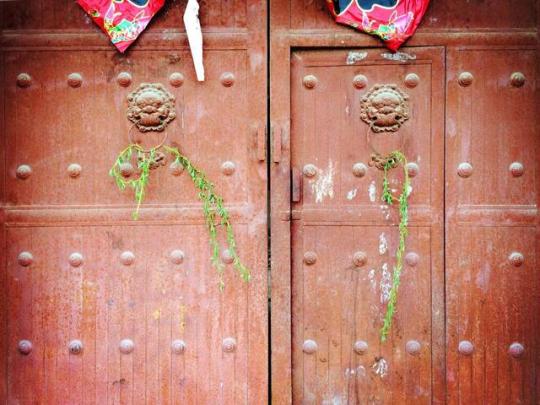
The custom is still widespread in parts of China especially Wudi(吴地) area: area in the south of the Yangtze River
----
In ancient times, there were many interesting Qingming Festival customs. Apart from visit the tombs of their ancestors to clean the gravesites and make ritual offerings to their ancestors, there were also a series of custom sports activities such as spring outing, swinging, Cuju (蹴鞠:is an ancient Chinese ball game) , playing polo etc.
_______
🧚🏻Recreation Work:@吃货娃娃
🔗Weibo:https://weibo.com/1868003212/MAyid6Mtv
_______
#Chinese Hanfu#hanfu#early qing dynasty#Ming Dynasty#Late Ming Period#Qingming Festival/清明節#Chinese Culture#chinese customs#hanfu accessories#chinese traditional clothing#chinese#chinese historical fashion#historical fashion#吃货娃娃#插柳/戴柳
147 notes
·
View notes
Text
April 12, Xi'an, China, Qinglong Temple/青龙寺 (Part 3 - History):
A model of Qinglong Temple in Tang dynasty (618 - 907 AD):

There must have been something like thirty engravings of famous poems about the temple lining the walls of the corridors. Below are three examples of these engravings, from these poems one can get a feel for how Qinglong Temple used to look like. A note on the translations: they are rather unpolished as I just wanted to get the meaning across.

《題青龍寺詩》 [唐] 朱慶餘 寺好因崗勢,登臨值夕陽。 青山當佛閣,紅葉滿僧廊。 竹色連平地,蟲聲在上方。 最憐東面靜,為近楚城墻。
Translation (by me):
"In Commemoration of Qinglong Temple" By Zhu Qingyu (Tang dynasty) The beauty of this temple comes from the mountains, By the time I summited it was already dusk. Verdant peaks behind temple buildings, Scarlet leaves filling the corridors. Bamboo groves connecting flat areas, Chirping of insects above it all. Only the east side remains still, Since it's close to the city walls.

《清明日青龍寺上方賦得多字》 [唐] 皇甫冉 上方偏可適,季月況堪過。 遠近水聲至,東西山色多。 夕陽留徑草,新葉變庭柯。 已度清明節,春秋如客何。
Translation (by me):
"Qingming Festival Above Qinglong Temple" By Huangfu Ran (Tang dynasty) It's comfortable up in the mountains, Watching the season pass by. Sounds of flowing water from near and far, Views of mountains from east and west. Setting sun upon the grassy path, Growing leaves cover the courtyard trees. Qingming Festival has come and gone, Just like the seasons and the temple visitors.

《青龍寺早夏》 [唐] 白居易 塵埃經小雨,地高倚長坡。 日西寺門外,景氣含清和。 閑有老僧立,靜無凡客過。 殘莺意思盡,新葉陰涼多。 春去來幾日,夏雲忽嵯峨。 朝朝感時節,年鬓闇蹉跎。 胡爲戀朝市,不去歸煙蘿。 青山寸步地,自問心如何。
Translation (by me):
"Early Summer at Qinglong Temple" By Bai Juyi (Tang dynasty) Light shower settled the dust, Temple grounds blending with the hills. Setting sun outside temple gates, The scene filled with an air of serenity. An old monk stands in idleness, There are no worldly passersby in the stillness. Remaining birds having sung their melodies, New leaves providing ample amounts of shade. End of spring was just days ago, Summer clouds are already towering above. Every day we feel the passing of seasons, Our hair graying in the meantime. Why obsess over bustling cities, When we can return to the lush countryside? These verdant mountains are but a corner of the world, Here I stand and reflect upon the state of my heart.
Huiguo and Kukai
In the first part I mentioned that Qinglong Temple was where Kukai/空海 studied Vajrayana Buddhism (the Chinese Esoteric tradition was also called "Tangmi"/唐密, since it was very popular in Tang dynasty) under Huiguo/惠果. Huiguo was a student of the famous Vajrayana Buddhist master and translator Amoghavajra (Chinese name Bukong/不空). Huiguo eventually became a master himself in the Chinese Esoteric tradition, and was an Acharya (Sanskrit term meaning teacher; translated phonetically as asheli/阿阇黎 in Chinese) who had many students from different places, including from surrounding countries. Kukai was one of his last notable students before he passed away. Kukai returned to Japan in 806 AD and founded the Shingon school of Buddhism/真言宗 (also sometimes called Eastern Esotericism/東密).
Kukai was also a calligrapher and a poet, below are two examples of his works (first is an ink rubbing of his calligraphy work titled "Buddha", second is his calligraphy work named Huushincho/風信帖; both were written in Chinese):


Closeup of Huushincho (from Wikipedia). The original is at Touji Temple in Kyoto, Japan.

Shōryō shu/Xinglingji/性靈集, a collection of kanshi by Kukai. Kanshi/漢詩 is a Japanese word for Chinese poetry. These books here are a gift from Japan.

Bunkyō hifu ron/Wenjingmifulun/文鏡秘府論 by Kukai which discusses Chinese poetry. These books are a gift from Japan.

There are also other gifts from Japan. Left is the top of a khakkhara staff (In Chinese and Japanese: xizhang/锡杖/錫杖, shakujō/錫杖). Right is a Vajra (in Chinese and Japanese: jingangchu/金刚杵/金剛杵, kongosho/金剛杵), this is a Vajrayana ritual object. This particular Vajra is commemorative and bears the names of Huiguo and Kukai:


And that's all for Qinglong Temple. Next up is another famous temple in Xi'an, Daci'en Temple/大慈恩寺.
#2024 china#xi'an#china#qinglong temple#buddhist temple#history#chinese history#vajrayana buddhism#kukai#huiguo#buddhism#poetry#chinese poetry#my translations
97 notes
·
View notes
Text
[CN] Shaw's 2023 Birthday R&S
⚡ Warning: This post contains detailed spoilers for a R&S which hasn't released in EN yet!⚡

[Released Date: 16 June 2023]
[This content was translated with the help of Google translate and by my lovely friend XD]
✧[Chapter 1]✧
Shaw walked unhurriedly on the path on one side, and the earphone cable on his chest also dangled. It wasn't until a fork in the road appeared that he was finally willing to lift his eyelids and look left and right.
It was still the bat’s road on the left, two or three vehicles were parked there.
To the right, there was a gentle slope upward, and between the layers of trees, you can see a tombstone standing there, as well as two or three places where white smoke drifts out due to worship.
Since the burial of the old man, this is the second time he came here. Hardly a year has passed by but there were a lot more tombstones than before, and he couldn't even find where he was.
But Shaw wasn't in a hurry, he put his hands in his pockets, and walked east without hesitation. No matter how much this place changes, going to somewhere with the best Feng Shui never goes wrong.
[T/N]: Feng Shui is an ancient Chinese art of arranging buildings, objects, and space in an environment to achieve harmony and balance in a way that will bring peace and prosperity. Or in simple having luck with the environment!
So it didn't take long for Shaw to stand in front of the old man's tombstone without any problems. After staring at the photo that’s mosaicked in the middle, he reached out and pulled out the earphones.
“Hey, old man.”
“I can't believe I chose this photo, you're the one with the biggest smile.”
Shaw raised his hand to brush off the dead leaves from the tombstone, but just with few strokes, his hands were covered with a layer of black dust.
“.........”
After a few moments of silence, he squeezed his hand around his white cuff and wiped the dust off the tombstone bit by bit.
“Old man, you are too far from the city center. So don't blame me for not frequently visting, just swear some words upon the sky.”
As Shaw spoke, he suddenly narrowed his eyes and sneezed several times in succession.
“... Mine was pretty fast.”
“Then you relax yourself first, I haven’t finished reporting. When I’m finished reporting, you can criticise me all you want.”
At this time, the right cuff had become black from dust, so Shaw pinched his left cuff, and continued to wipe the dust.
“Originally, I wanted to wait until Ching Ming festival to gave you a grave sweep, although i don’t visit so often, certain rules still has to be followed”
[T/N]: 清明節 Ching Ming or Qingming festival means the Remembrance of Ancestors Day or Grave-Sweeping Day takes place on the 15th day after the Spring Equinox.
“But I’ll be busy with some school stuff at that time, so I came early,”
“As for the antiques...everything is fine, except that your business has been reduced a lot without you.”
“You also know that I don't like making trouble, so I'll try my best not to lose money for you. Oh, and there's one more thing— —
“I accidentally broke a cup of yours some time ago. Fortunately, it was only from the Qing Dynasty. In addition, it was repaired in time, so the loss is not big. I just feel sorry for your old age, so I will pay you more.”
Shaw lifted the plastic bag that he brought all the way here and shook it in front of the tombstone. After shaking it, he took out a still warm roast chicken, three or two fruits and a handful of original melon seeds from it.
Then, he glanced at the bottle of sake left in the bag, and raised the corners of his lips slightly.
“Remember it all, all of them are your favorites.”
After pouring the sake into a small glass, he finally straightened up and fell into complete silence, and without his voice, the place was even quieter, with only a string of heavy metal sounds slipping out of the headphones which were half-dangling out of his pocket.
“.......”
“It's all me talking, so it's boring.”
When Shaw raised his foot and was about to leave, he suddenly thought of something and took out a few copper coins from his pocket.
“Old man, you say I can do divination, can you tell me what you want to say to me through divination?”
Jingle—
The coins were thrown up and scattered on the ground, Shaw bent down and looked at them, and laughed.
“It's amazing, it seems to be there.”
He said, glanced at the sake cup that was only 70% full, and then picked up the sake bottle to fill it.
“Okay, I'll fill you up, but don't be too greedy. I'm really leaving this time, and I'll come see you when I have time.”
After Shaw finished speaking, he left without looking back. Only the small sake bottle was left, and the sake made silent waves with the wind.
On the way back, the sky was gloomy, and Shaw was still walking slowly when, a lingering smoke of plant ash floated behind him, and an old lady who seemed to have just finished sweeping the grave hurriedly rushed ahead of him.
“Young man, hurry up, it's going to rain heavily.”
Shaw took a look at the sky, and then kicked a stone on the side of the road.
"What a stupid rain."

✧[Chapter 2]✧
After returning to the antique shop, the dust on the cuffs had condensed into a ball.
Shaw didn't take off his coat, he directly took out a dust pan and broom from a corner of the backyard. Originally, he hadn't planned to clean it today, but the layers of dirt accumulated during the tomb sweeping made him realize that it hadn't been cleaned for a long time.
But when Shaw stood in front of the secret room with the broom, he never pressed the switch.
Since the old man left, he almost never went in there again. Even if he wanted to get some necessary things, he would just quickly go in and come out immediately, without any extra stops.
He couldn't say why he didn't want to go there, but he didn't want to "get to the bottom of it". He always felt that once he did so, a lot of troublesome emotions would come up.
So at last he turned and left, and went back to the door.
“Forget it, let's talk about it another day. You can't finish so many things in half a day.”
He began to sweep and drag the chair, and the harsh sound made from time to time made the parrot in the cage jump up and down as if startled.
Shaw stopped moving again and pinned the broom to the ground, “What, are you going to give your cage a big cleaning too?”
Seeing that the parrot continued to flutter its wings, he silently picked up the water basin on the side and walked towards the door.
“Okay, your voice is really precious, I've been raising you for four or five years, and I haven't seen you say a few words.”
After speaking, he lifted the water basin and poured towards outside, "Hey, what a coincidence, I bet you brat purpousefully poured it towards me!"
The old man just stepped into the antique stop and almost got splashed by water, his feet were shivering on the dry floor like an electric shock.
Seeing this, Shaw just shrugged his shoulders, picked up the mop and started mopping the floor, “You also said it's a coincidence, don't touch the porcelain”
“……Come on, I'm too old to argue with a kid like you.”
Old Yan put his hands behind his back and began to look at the "renewed" antique shop, with a puffing sound coming from his mouth.
“I was just next door when I heard your bells ringing, so you were giving it a cleaning .”
“Could it be that you have been enlightened by the Buddha's light, and you are finally willing to take care of this antique shop for your master and inherit the mantle?”
“........”
“Out of the way.”
Seeing that the broom almost reached his front foot, Old Yan immediately step back, Shaw slightly opened his mouth again. “Move to the left, there’s a treasure on the right.”
Old Yan subconsciously put his foot on brakes, and when he looked back, his face turned pale.
“This, the authentic work of Huang Tingjian, you put it here?”
“It's been raining for a while, and it's hard to come across a dry, cloudy day, so I took it out to dry.”
Old Yan's body went rigid, as if he hadn't recovered from the fright just now, “Anyway, put it in a safe place, I was almost knocked down by it just now!”
Shaw remained expressionless, silently putting down the mop in his hand.
“Old Yan. When it was first discovered, it didn't know that it would last for a hundred years or that it would be trapped in a wooden box by future generations.
“It's not too much to let it out once in a while to feel the breeze, right?”
Old Yan was stunned for a moment, his eyes even showed a few moments of longing, and then turned away.
“...... Why do you always come and then disappear?”
Old Yan didn't turn around, the afterglow quietly fell on his back.
“I won't be coming back today.”
…. It’s almost an year, how come today thinking about the scenery of my master enjoying chatting with these precious antiques comes to mind.
And then, there was only a sigh left at the corner.
The antique store was empty again, and the parrot was quiet.
Shaw didn't clean up any more, just leaned casually to one side, looked at the calligraphy and painting quietly for a long time, and then raised the corners of his lips.
“Surely you miss him too?”
“It's so awkward.”
Shaw shrugged, pretending to be indifferent, and when he was about to continue mopping the floor, a black shadow broke into the corner of his eye and stood at the door of the store.
He turned his head and saw the black letter 5 with a slightly raised tail engraved on the man's earphone.

✧[Chapter 3]✧
At dawn, Shaw walked quickly in the forest, dragging his bleeding left leg.
“This time the "extra money" was harder to earn than imagined, but fortunately the things have been successfully obtained, and the rest is to extort more "loss fees" from BS.”
As he was thinking, his vision suddenly blurred, causing him to run and hold onto a tree trunk and look down at the wound.
Even wearing black pants, you can still see that the place cut by the blade is bloody, surrounded by a network of broken fabric on the top, oozing black and blue blood.
“.......”
It seems that the tip of the knife seems to be poisoned.
He frowned and quickened his pace, walking towards the exit not far away. But the weird thing was, it’s clearly located in front by less than a metre, but he’s like stuck in cycles, spinning around in the same spot.
It wasn't until the third attempt that Shaw finally stopped beside the tree trunk he had carved a mark on.
“Tsk, do you really think these tricks can work on me?” Shaw gritted his teeth and complained, then simply closed his eyes.
How treacherous is the illusion?
And there was no escape from the four-element, eight-diagram array.
The next second, the off by hard memorised Eight Front Strategy taught by that old man, spread out from a circle supported by two legs in his heart. But as soon as he stepped on the “kun word”, a dazzling light wrapped him up.
He opened his eyes slightly, and found that the source of the light was actually coming from the dragonfly eye worn on his chest.
Shaw took off the chain in surprise and twisted it, but before he could continue looking, that dazzling light burst out again, completely engulfing his sight.
When he opened his eyes again, it was completely black.
“.......”
Shaw subconsciously stretched out his hand, but before his arm was straightened, his palm first met a rough and hard touch, like a pitted stone wall.
Just now it was an open forest, how did it become like this in the blink of an eye? He frowned and took out his phone to turn on the flashlight mode, the moment it illuminated, the surrounding environment was completely out of his expectation.
He was in a closed and narrow "passage", the rocks above his head could be touched by his feet, and the air was thin, with a cold, damp stench.
It was as if this place had never seen the light of the day.
“What's going on?”
Shaw endured the pain and walked a few steps, until he encountered a fork in the road, he turned his head sideways and looked in the two places.
Under the sweeping light of the flashlight, he saw some pottery and ironware on the ground, and a set of chime clocks were displayed in the distance, arranged in order from small to large at the bottom of the wall.
At this moment he felt something was wrong. After all, he grew up on West Moon Street, and he was surrounded by the old man every day. Even if he hasn't experienced it himself, he can probably tell that this was the place where the ancients lived in the legend.
“........”
How come when this thing lights up, he comes here?
He stared at the Dragonfly's Eye in his hand for a while, puzzled. But he didn't see anything unusual. His intuition told him that there must be a hidden secret. That's why the old man never explained it, but only entrusted him to take good care of it….
Just as he was thinking, a benevolent voice came from the storage room, Shaw immediately came back to his senses, and walked with light footsteps. And when he walked to the entrance of the side room, he saw an old-fashioned flashlight lying on the ground, looking along the bright light, a young man in a crumpled Chinese tunic, whose leg was firmly pressed by a broken stone slab.
Shaw didn't move for a while, just watched this strange young man scrambling back and forth on the ground, sweating profusely and grinning.
When he finally pulled his foot out of the gap, he stood up half-heartedly, looked up and saw Shaw standing at the door, and almost fell to the ground again in fright.
“You, who are you?”

✧[Chapter 4]✧
Before the words fell, Shaw's flashlight was directed on the young man's face.
“You don't care who I am. You've got a lot of nerve, what kind of society is this, and you still dare to put yourself in danger?”
While the young man was blinded by the light, Shaw frowned.
He always thought this square-faced man looked a bit familiar.
But in the next second, the young man blocked the dazzling light with his hand. Seeing that he didn't reply for a long time, Shaw moved the flashlight to his hand again, and shook it lightly.
“Don't play dumb, this jade bead is the treasure you want to take away, right?”
“How about this, give you a chance to redeem your sins, you give it to me, and I'll handed it in for you.”
The young man immediately put the round white jade beads behind his back, his face full of indignation.
“You, what do you think of me? I was going to hand it over to the museum. This is a stone bone white jade, which belongs to our cultural product of the Western Han Dynasty. It is impossible to hand it over to someone with unknown origin like you!”
"You don't look like a good person with that hair color of yours, maybe you are with that group of foreign thieves!"
Shaw was listening and ran a hand over his blue purplish hair.
“Okay, not just a reckless man, but also quite knowledgeable, but you are wrong about one thing, this is not the Western Han Dynasty, but also the Ming Dynasty.”
As Shaw said, he shone the flashlight on the heavy wooden box behind the young man.
“This is lime sand made by mixing lime, glutinous rice, and sand. No one would do this before the Ming Dynasty.”
The young man froze for a moment, leaned over to take a look, and when he turned his head, the vigilance in his eyes was replaced with curiosity.
“....Where did you learn this from?”
"You wouldn't believe it if I told you, how about it? Want to give it to me?"
Seeing Shaw taking a step forward threateningly, although the young man was afraid, he still firmly guarded the jade bead in his hand, as if he would rather smash the jade than give it up
“I'm not going to hand it over to you no matter what you say.”
“It has been sealed for centuries, and I will not allow its future fate to remain in the hands of wealthy merchants.”
“It should be seen by the world, it is history, it is culture!”
“Not synonymous with money!”
The young man's cheeks were red, and his voice became more and more subdued, as a resy Shaw couldn't hold back his laughter.
“I finally remembered who you look like, your accent, tone of voice, and a face that couldn't be more square .......”
“Just like the old man.”
Shaw scannedthe young man up and down while speaking, “It's okay for you to play retro style, no problem, but it does’nt suit that face of yours, too old looking, I advise you to put that big head down......”
Before he could finish the sentence, a dazzling ray of light flashed on his chest again.
It's the dragonfly eye.
“This is the Warring States glazed dragonfly eye, why do you have it?! I clearly —”
Shaw couldn't hear anything, the shining white light completely enveloping him.

✧[Chapter 5]✧
In the following week, Shaw searched all over the antique shop, but he couldn't find any information about the Dragonfly Eye.
After a long silence, he finally raised his hand and pressed the switch on the back of the antique shelf, and entered the secret room. With the kerosene lamp in his hand, he stared in silence at everything before him - an ancient book lined up on a wooden table at the end, a magnifying glass at the foot of the page, and a sperm tilted against the door.
There are "traces" left by the old man from the last time everywhere.
That's why he doesn't like to come to this place.
He didn't know whether to tidy up the messy secret room or keep it as it was.
He always feels that once these are returned to their original places, time will take advantage of them and erase all the traces left on them. So when Shaw searched, he deliberately avoided touching these things.
The kerosene lamps began to fade but he still found nothing. The only accidental discovery was a dusty wooden box dragged out from the bottom shelf of the ancient shelf-
It contains a red hardcover photo album, and some fragmentary objects.
Shaw didn't think twice and opened the first page.
What caught his eyes were four black and white group photos, each photo has seven or eight young people in Chinese tunic suits smiling shyly.
In the next second, Shaw's fingertips holding the album tightened a little bit.The person standing on the far right of the photo was a young man with curly hair and a square face.
“.........”
He subconsciously held his breath.
Obviously the guess was right, but he was still stunned, he continued to flip the pages in a daze.
There weren't many photos of this man, but you can tell that he has slowly changed over time - he has become a little fatter, his face has more wrinkles, and his hair has turned gray. In the end, it became the most familiar appearance to him.
“……..”
When everything was irrefutable, Shaw couldn't help but smile, only the undetectable regret remained in his eyes.
“....Old man, you are very interesting. Hiding so many secrets from me...But it's okay, just leave it as a mystery for me to solve by myself.”
“Sooner or later, I will know whether that person was my hallucination, or I really met you.”
When he put the photo album back, he found an old notebook underneath.
“There are a lot of things.”
He flipped through a few pages, which contained the old man's notes on studying antiquities when he was young, and some essays—
“History is not as old as you imagined, as long as you see it, touch it ...... Naturally, you’ll become a part of history.”
[T/N]: Please take note of this line and don’t forget it, cuz it holds a special meaning behind it and play a big role in his bday date which will also be explained later ;)
Seeing this, Shaw inadvertently looked at the ancient books, calligraphy and paintings in front of him. For some reason, these things that he has been accustomed to since he was a child, seem to have undergone different changes at this moment.
It seems that through these, we can see the past and see the freshness of the past.
Thinking of this, he raised his hand and placed it on one of the ancient books.
Has he become a part of history? To be honest, he has doubts, but there was nothing he could do about it.
Because the only person he can ask has become “history”.

✧[Chapter 6]✧
The time has come for the summer solstice, and the cicadas are chirping even more.
He patted the dust on his hands before picking up his phone and glancing at it - [Speedy Skateboard Shop] Dear member, happy birthday! Coupons have been added to your account, welcome to shop! Remember to subscribe back.
Shaw didn't even think about going back, and walked straight into the shop. It's been more than a year and a half now, and it's time to come to the store to make an account. Even if he doesn't bother to take care of the business, some basic things still have to be done.
But when he took out the calculator from the drawer, he found that there were stickers on the bottom of a business card.
He tore it off casually, and found that it was not only crumpled, but also had many cake patterns printed on it, one of which was the peach cake.
When Shaw saw this, he couldn't help laughing.
“Old man, aren't you hinting at something again?”
However, the only answer to him was a beep.
But Shaw didn't mind, and laughed even more.
“Okay, I've been eating it for so many years, and I would feel uncomfortable if I suddenly stopped this year.” He picked up the landline beside him and dialed the number from the business card to see if he could buy it.
After a while, the phone was connected by an aunt with a northern accent, ”Master Hua, why did you call this year? Don't you usually order it a few days ago? But it's okay, the birthday cake has been reserved for you.”
“What do you say, when will you come to pick it up? I'm off work soon.”
Shaw held the phone tightly, “Now”
She seemed to realize that it wasn't Master Hua's voice, and the other party was taken aback for a moment, “Oh, it's not Master Hua? Then will you help him get the cake from here? Or would he be getting it himself?”
“........”
"He's not coming, I'll get it myself."
The time Shaw finished taking the cake and returned to the antique shop, it was already dark…
Without saying anything, he cut a piece of longevity peach cake and put it on a plate, and ate it quietly. But yes, what can change dramatically in the past year?
Shaw paused for a moment while eating the cake, and there was a glimmer of darkness in his eyes.
He couldn't say that, except for this cake, there were quite a lot of changes.
“Stinky boy! Stinky boy!”
At this moment, it was as if a stone had hit the calm lake. Shaw straightened up suddenly, and looked at the parrot who had finally opened its mouth. It was obviously still dark on the street, but time seemed to be turning backwards, and the bustling noises of the daytime could be heard next to his ears— —
“Old man, can you stop nagging me? This chicken is learning to talk, I don't want another bird to scold me.”
“Brat, if you were less of a troublemaker, could I say that?”
“...stinky old man,”
“Well, you brat!”
When this past incident came to Shaw's mind, he couldn't help laughing, not even noticing the cream on the corner of his mouth.
He continued to fork a piece of yellow peach and put it in his mouth,
“Old man, what did I say? You can't say everything out loud.”
“The bird always learn the bad, not the good.”
The night was quiet again, and the parrot also lowered its head and combed its feathers,
Shaw looked at the empty antique shop, picked up a candle and stuck it in the cake.
After lighting, the warm light of the candle reflected on Shaw's face, the youthful nostalgia and resignation were reflecting out.
“......Old man.”
“All these years, I haven't been very filial to you, I happened to turn 18 this year, so let's set an example.”
“To be your good disciple for once.”
“Your antique store, the treasures you receive with love, the "history" you cherish”
“I'll take care of it for you.”
—
#please read this with a pinch of salt and I suggest you to prepare lots of tissues 😭#this r&s takes place when he just turned 18#and there's a hell lot of information about his master and a little bit of the dragonfly necklace ��#honestly this r&s nearly made me teared up when I find out how he was trying to keep himself in one piece after losing his master😭#and that last scene nearly break me in hysterical cries🤧#you guys honestly don't know how much I wanted to pull him in a hug and tell him that it's alright 🥺#mlqc spoilers#mlqc cn#mlqc shaw#mlqc ling xiao#mlqc translations#mr love queen's choice#mlqc#love and producer
59 notes
·
View notes
Text

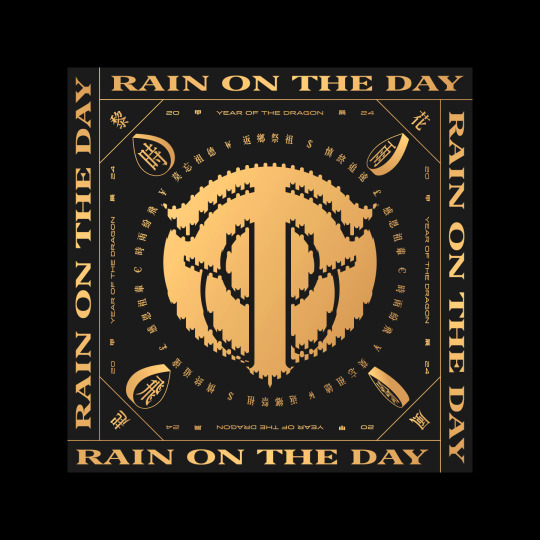

⓿⓿❸/ ⓿⓿❾ 𝝜𝝾𝗹𝗶𝗱𝗮𝘆 𝝩𝘆𝗽𝗲 : 雨 - 清明時節雨紛紛,路上行人欲斷魂, 小時候讀到這句覺得怪恐怖的, 可能以前沒有連假,大家不開心。 - [Holiday Type] is a series of type and layout design inspired by traditional holidays and festivals in Taiwan. - It’s Qingming Festival holiday. Normally a rainy day 🌧️ - - -
#typedesign#lettering#graphicdesign#chinesetype#graphicradar#typography#typographic#type#logo#logodesign#logotype#customtype#goodtype#graphik#eyeondesign#文字設計#平面設計#做字#作字#標準字#字體練習#字体#漢字#디자인#타이포#인생도#타이포그래피#로고#로고디자인제작
2 notes
·
View notes
Text
Holidays 4.5
Holidays
Accelerate ACL Awareness Among Young Women Day
Babu Jagjivan Ram Jayanthi (Andhra Pradesh, Telangana, India)
Bell Bottoms Day
Children’s Day (Palestine)
Chungmyung Day (North Korea)
Easter Island Day
First Contact Day (Star Trek)
German-Americans Day
Global Crowdfunding Day
Go For Broke Day
Golden Rule Day
International Calm Day
International Day of Conscious
International Dimetrodon Day
International OCNDS Awareness Day
International Poppers Day
Lady Luck Day
Make Your Children Laugh Day
National Biomechanics Day
National Body Care Day
National Dandelion Day
National Flash Drive Day
National Gold Star Spouses Day
National Maritime Day (India)
National Nebraska Day
National Read a Roadmap Day (a.k.a. Learn to Read a Roadmap Day)
National Self Care Day
National Star Phone Certification Day
Origin of the Species Day
R.E.M. Day
Sikmogil (Arbor Day; South Korea)
Talk Talk Day
Veto Day
Western Hemisphere Ports Day
Food & Drink Celebrations
Molasses Day
National Caramel Day
National Deep Dish Pizza Day
National Raisin and Spice Bar Day
Peeps Day
1st Wednesday in April
Donate Life Living Donor Day [1st Wednesday]
Global Day (a.k.a. Global Day of the Engineer) [1st Wednesday]
National Day of Hope [1st Wednesday]
National Walking Day [1st Wednesday]
Paraprofessional Appreciation Day [1st Wednesday]
Safe Place Selfie Day [1st Wednesday]
Whole Grain Sampling Day [1st Wednesday]
Feast Days
Aequinoctium Vernum VII (Pagan)
Æthelburh of Kent (Christian; Saint)
Albert of Montecorvino (Christian; Saint)
Becan of Ireland (Christian; Saint)
Cold Food Festival [Begins 15th Day of Spring Equinox; Ends 4.6] (a.k.a. …
Hanshi Festival (China)
Hansik (South Korea)
Tết Hàn Thực (Vietnam)
Derfel Gadarn (Christian; Saint)
Fortuna Publica (Festival of Good Luck; Ancient Rome)
Full Moon [4th of the Year] (a.k.a. ...
Awakening Moon (Neo-Pagan)
Breaking Ice Moon (Traditional)
Budding Moon of Plants and Shrubs (Traditional)
Egg Moon (Alternate)
Fish Moon (Alternate)
Flower Moon (Cherokee)
Gold Star Spouses Day
Grass Moon (Alternate, North America)
Growing Moon (Celtic)
Hunter’s Moon (South Africa)
Moon When the Ducks Come Back (Traditional)
Peony Moon (China)
Pink Moon (Amer. Indian, Traditional)
Planter’s Moon (Colonial)
Seed Moon (England, Wicca)
Southern Hemisphere: Blood, Harvest, Hunter’s
Wildcat Moon (Choctaw)
Gerald of Sauve-Majeure (Christian; Saint)
Hero (Positivist; Saint)
Holy Wednesday [4 Days before Easter]
Jean-Honoré Fragonard (Artology)
Juliana of Liège (Christian; Saint)
Maria Crescentia Höss (Christian; Saint)
Mariano de la Mata (Christian; Blessed)
Nones of April (Ancient Rome)
Pandita Mary Ramabai (Episcopal Church (USA))
Passover begins (at Sundown; a.k.a. Pesach; Judaism) [Nisan 15]
Pizza Day Day (Pastafarian)
Robert Bloch Day (Church of the SubGenius; Saint)
Ruadhán of Lorrha (Christian; Saint)
Scuzzina (Muppetism)
Sunning of the Buddha (Tibet)
Ta’anit Bechorot (Firstborn Fast Day; Judaism) [14 Nisan]
Tigernach of Ireland (Christian; Saint)
Tomb Sweeping Day (掃墳節) [Begins 15th Day of Spring Equinox; Ends 4.6] (a.k.a. …
Ancestors' Day
Chinese Memorial Day
Ching Ming Festival (清明節; China)
Qingming Jie (清明节; China)
Shīmī (Ryukyu Islands)
Vincent Ferrer (Christian; Saint)
Lucky & Unlucky Days
Butsumetsu (仏滅 Japan) [Unlucky all day.]
Nēmontēmi, Day 1 (of 5) [Aztec unlucky or fasting days, taking place between 4.5-4.18]
Premieres
Adventure Time (Animated TV Series; 2010)
Air (Film; 2023)
Amadeus (Film; 1985)
The Art of Vacationing (Disney Cartoon; 2012)
The Barnyard Concert (Disney Cartoon; 1935)
Brockmire (TV Series; 2017)
Carnegie Hall Concert, recorded by Chicago (Concert Album; 1971)
Carrie, by Stephen King (Novel; 1974)
Die Fledermaus, by Johann Strauss (Operetta; 1874)
Donald’s Dog Laundry (Disney Cartoon; 1940)
Double Trouble (Film; 1967)
Live and Let Die, by Ian Fleming (Novel; 1954) [James Bond #2]
Married… with Children (TV Series; 1987)
Moon Pilot (Film; 1962)
Moonraker, by Ian Fleming (Novel; 1955) [James Bond #3]
National Lampoon’s Van Wilder (Film; 2002)
One Dance, by Drake (Song; 2016)
Pete Kelly’s Blues (TV Series; 1959)
Pretty Baby (Film; 1978)
Shazam! (Film; 2019)
Something To Be, by Matchbox Twenty (Album; 2005)
The Sugarland Express (Film; 1974)
Tracy Chapman, by Tracy Chapman (Album; 1988)
Unicorn Store (Film; 2019)
Van Wilder (Film; 2002)
We Are the World (Song; 1985)
Today’s Name Days
Crescentia, Vinzenz (Austria)
Irena, Vinko (Croatia)
Miroslava (Czech Republic)
Irene (Denmark)
Ireene, Irene, Reena, Reene, Rena, Renate (Estonia)
Ira, Irene, Irina, Iro (Finland)
Irène (France)
Crescentia, Juliana, Juliane, Vinzenz (Germany)
Giota, Giotis, Panayotis, Panagiotis, Panagis, Panagos, Panagiota, Panayota, Panagioula, Panagoula, Pani, Panikos, Panos, Panousos, Pegie, Pegy, Takis, Tota, Toula, Yiota, Yiotis (Greece)
Vince (Hungary)
Cenzo, Eva, Vincenzo (Italy)
Mirjama, Vidaga, Vija, Virdžīnija (Latvia)
Irena, Rimvydas, Zenius, Zenonas, Žygintė (Lithuania)
Eiril, Eirin, Irene (Norway)
Borzywoj, Irena, Wincenty (Poland)
Agatopod, Teodul (Romania)
Miroslava (Slovakia)
Vicente (Spain)
Irene, Irja, Nanna (Sweden)
Chandra, Ethelburga, Irene, Irina, Tyler, Tylor (USA)
Today is Also…
Day of Year: Day 95 of 2024; 270 days remaining in the year
ISO: Day 3 of week 14 of 2023
Celtic Tree Calendar: Fearn (Alder) [Day 18 of 28]
Chinese: Second Month 2 (Gui-Mao), Day 15 (Gui-Si)
Chinese Year of the: Rabbit 4721 (until February 10, 2024)
Hebrew: 14 Nisan 5783
Islamic: 14 Ramadan 1444
J Cal: 4 Aqua; Foursday [4 of 30]
Julian: 23 March 2023
Moon: 100%: Full Moon
Positivist: 11 Archimedes (4th Month) [Hero]
Runic Half Month: Ehwaz (Horse) [Day 11 of 15]
Season: Spring (Day 17 of 90)
Zodiac: Aries (Day 16 of 30)
1 note
·
View note
Text
Holidays 4.5
Holidays
Accelerate ACL Awareness Among Young Women Day
Babu Jagjivan Ram Jayanthi (Andhra Pradesh, Telangana, India)
Bell Bottoms Day
Children’s Day (Palestine)
Chungmyung Day (North Korea)
Easter Island Day
First Contact Day (Star Trek)
German-Americans Day
Global Crowdfunding Day
Go For Broke Day
Golden Rule Day
International Calm Day
International Day of Conscious
International Dimetrodon Day
International OCNDS Awareness Day
International Poppers Day
Lady Luck Day
Make Your Children Laugh Day
National Biomechanics Day
National Body Care Day
National Dandelion Day
National Flash Drive Day
National Gold Star Spouses Day
National Maritime Day (India)
National Nebraska Day
National Read a Roadmap Day (a.k.a. Learn to Read a Roadmap Day)
National Self Care Day
National Star Phone Certification Day
Origin of the Species Day
R.E.M. Day
Sikmogil (Arbor Day; South Korea)
Talk Talk Day
Veto Day
Western Hemisphere Ports Day
Food & Drink Celebrations
Molasses Day
National Caramel Day
National Deep Dish Pizza Day
National Raisin and Spice Bar Day
Peeps Day
1st Wednesday in April
Donate Life Living Donor Day [1st Wednesday]
Global Day (a.k.a. Global Day of the Engineer) [1st Wednesday]
National Day of Hope [1st Wednesday]
National Walking Day [1st Wednesday]
Paraprofessional Appreciation Day [1st Wednesday]
Safe Place Selfie Day [1st Wednesday]
Whole Grain Sampling Day [1st Wednesday]
Feast Days
Aequinoctium Vernum VII (Pagan)
Æthelburh of Kent (Christian; Saint)
Albert of Montecorvino (Christian; Saint)
Becan of Ireland (Christian; Saint)
Cold Food Festival [Begins 15th Day of Spring Equinox; Ends 4.6] (a.k.a. …
Hanshi Festival (China)
Hansik (South Korea)
Tết Hàn Thực (Vietnam)
Derfel Gadarn (Christian; Saint)
Fortuna Publica (Festival of Good Luck; Ancient Rome)
Full Moon [4th of the Year] (a.k.a. ...
Awakening Moon (Neo-Pagan)
Breaking Ice Moon (Traditional)
Budding Moon of Plants and Shrubs (Traditional)
Egg Moon (Alternate)
Fish Moon (Alternate)
Flower Moon (Cherokee)
Gold Star Spouses Day
Grass Moon (Alternate, North America)
Growing Moon (Celtic)
Hunter’s Moon (South Africa)
Moon When the Ducks Come Back (Traditional)
Peony Moon (China)
Pink Moon (Amer. Indian, Traditional)
Planter’s Moon (Colonial)
Seed Moon (England, Wicca)
Southern Hemisphere: Blood, Harvest, Hunter’s
Wildcat Moon (Choctaw)
Gerald of Sauve-Majeure (Christian; Saint)
Hero (Positivist; Saint)
Holy Wednesday [4 Days before Easter]
Jean-Honoré Fragonard (Artology)
Juliana of Liège (Christian; Saint)
Maria Crescentia Höss (Christian; Saint)
Mariano de la Mata (Christian; Blessed)
Nones of April (Ancient Rome)
Pandita Mary Ramabai (Episcopal Church (USA))
Passover begins (at Sundown; a.k.a. Pesach; Judaism) [Nisan 15]
Pizza Day Day (Pastafarian)
Robert Bloch Day (Church of the SubGenius; Saint)
Ruadhán of Lorrha (Christian; Saint)
Scuzzina (Muppetism)
Sunning of the Buddha (Tibet)
Ta’anit Bechorot (Firstborn Fast Day; Judaism) [14 Nisan]
Tigernach of Ireland (Christian; Saint)
Tomb Sweeping Day (掃墳節) [Begins 15th Day of Spring Equinox; Ends 4.6] (a.k.a. …
Ancestors' Day
Chinese Memorial Day
Ching Ming Festival (清明節; China)
Qingming Jie (清明节; China)
Shīmī (Ryukyu Islands)
Vincent Ferrer (Christian; Saint)
Lucky & Unlucky Days
Butsumetsu (仏滅 Japan) [Unlucky all day.]
Nēmontēmi, Day 1 (of 5) [Aztec unlucky or fasting days, taking place between 4.5-4.18]
Premieres
Adventure Time (Animated TV Series; 2010)
Air (Film; 2023)
Amadeus (Film; 1985)
The Art of Vacationing (Disney Cartoon; 2012)
The Barnyard Concert (Disney Cartoon; 1935)
Brockmire (TV Series; 2017)
Carnegie Hall Concert, recorded by Chicago (Concert Album; 1971)
Carrie, by Stephen King (Novel; 1974)
Die Fledermaus, by Johann Strauss (Operetta; 1874)
Donald’s Dog Laundry (Disney Cartoon; 1940)
Double Trouble (Film; 1967)
Live and Let Die, by Ian Fleming (Novel; 1954) [James Bond #2]
Married… with Children (TV Series; 1987)
Moon Pilot (Film; 1962)
Moonraker, by Ian Fleming (Novel; 1955) [James Bond #3]
National Lampoon’s Van Wilder (Film; 2002)
One Dance, by Drake (Song; 2016)
Pete Kelly’s Blues (TV Series; 1959)
Pretty Baby (Film; 1978)
Shazam! (Film; 2019)
Something To Be, by Matchbox Twenty (Album; 2005)
The Sugarland Express (Film; 1974)
Tracy Chapman, by Tracy Chapman (Album; 1988)
Unicorn Store (Film; 2019)
Van Wilder (Film; 2002)
We Are the World (Song; 1985)
Today’s Name Days
Crescentia, Vinzenz (Austria)
Irena, Vinko (Croatia)
Miroslava (Czech Republic)
Irene (Denmark)
Ireene, Irene, Reena, Reene, Rena, Renate (Estonia)
Ira, Irene, Irina, Iro (Finland)
Irène (France)
Crescentia, Juliana, Juliane, Vinzenz (Germany)
Giota, Giotis, Panayotis, Panagiotis, Panagis, Panagos, Panagiota, Panayota, Panagioula, Panagoula, Pani, Panikos, Panos, Panousos, Pegie, Pegy, Takis, Tota, Toula, Yiota, Yiotis (Greece)
Vince (Hungary)
Cenzo, Eva, Vincenzo (Italy)
Mirjama, Vidaga, Vija, Virdžīnija (Latvia)
Irena, Rimvydas, Zenius, Zenonas, Žygintė (Lithuania)
Eiril, Eirin, Irene (Norway)
Borzywoj, Irena, Wincenty (Poland)
Agatopod, Teodul (Romania)
Miroslava (Slovakia)
Vicente (Spain)
Irene, Irja, Nanna (Sweden)
Chandra, Ethelburga, Irene, Irina, Tyler, Tylor (USA)
Today is Also…
Day of Year: Day 95 of 2024; 270 days remaining in the year
ISO: Day 3 of week 14 of 2023
Celtic Tree Calendar: Fearn (Alder) [Day 18 of 28]
Chinese: Second Month 2 (Gui-Mao), Day 15 (Gui-Si)
Chinese Year of the: Rabbit 4721 (until February 10, 2024)
Hebrew: 14 Nisan 5783
Islamic: 14 Ramadan 1444
J Cal: 4 Aqua; Foursday [4 of 30]
Julian: 23 March 2023
Moon: 100%: Full Moon
Positivist: 11 Archimedes (4th Month) [Hero]
Runic Half Month: Ehwaz (Horse) [Day 11 of 15]
Season: Spring (Day 17 of 90)
Zodiac: Aries (Day 16 of 30)
1 note
·
View note
Photo

“Offerings to the Dead” (from the collection of the Bancroft Library). An unknown photographer reputedly took the above photo (from the Bancroft Library) of what some commentators have stated was a “burial” on Laurel Hill in San Francisco, California, in 1892. As no actual burial appears in the scene, the caption for the photo may more accurately have captured the observance of Qingming by Chinese San Franciscans with attending onlookers.
Qingming, Legacy Cemeteries, and Early Chinese American Funerary Practices
The Chinese pioneers to North America brought with them their observance of Qingming (清明节), also known in English as “Tomb-Sweeping Day”(掃墳節). Qingming falls on the first day of the fifth solar term of the lunar calendar, usually the 15th day after the Spring Equinox, which can either be 4, 5 or 6 April in a given year.
Historian Thomas W. Chinn in his book, Bridging the Pacific, described the day when families visit the tombs of their ancestors as follows:
“The pure brightness Festival (Ching Ming) is the Chinese version of Memorial Day. Visits to family tombs are a formal right in China. Because the Chinese in America were far from the family tombs of their native Villages, they would visit the local Chinese Cemetery area on this day. Various associations erected “spirit” shrines for those who had no loved ones buried in the area.
“In the San Francisco area, Ching Ming is generally celebrated on a Sunday early in April. Before World War II, Chinese could not be buried in Caucasian cemeteries, so Chinese cemeteries were established near Colma, California, South of San Francisco. Buses in carloads of Chinese would travel to Colma on Ching Ming to visit the shrines or the graves of loved ones.
“At the tomb, the elder of the family would carefully sweep the graves with willow branches to repel evil spirits. Then the family would clean and pull weeds from the grave. The final ritual involved laying cooked food in dishes before the graves for the deceased to “eat.” After a while, the roast pig, chicken, buns, and so on would be eaten as a picnic lunch at the site. Following lunch, wine would be poured on the ground, after which the remaining food was removed and taken to different families. No food was wasted.
“During the course of the ceremony the spirit offering would be made, consisting of lighted incense sticks and red candles, which, together with paper money and paper clothing (sold in certain stores in Chinatown), were burned and dust transmitted to the deceased for their comfort and needs in the spirit world. While these offerings were being burned, firecrackers were exploded to confuse evil spirits and keep them from pursuing the deceased. These same rituals are still observed by most of the older generation of Chinese in America, although offerings of food and incense and the exploding of firecrackers are not as common today.
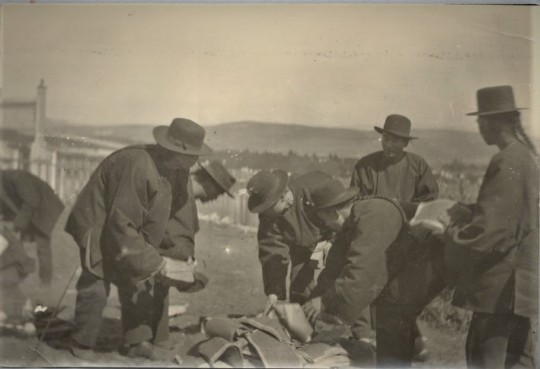
“Funeral at Gravesite,” no date. Photographer unknown (from the collection of the California Historical Society). According to Woody LaBounty of the Western Neighborhoods Project, the location was probably the San Francisco cemetery in what is now the city’s Lincoln Park and golf course. “The camera person was facing to the northeast,” according to LaBounty. “The small building visible in the photo is the caretaker's cottage of the German M. B. Society. It would take a bit of work to say which plot the photo was taken in, but it could probably be done. [This and the following image] were apparently taken only a few seconds apart.”
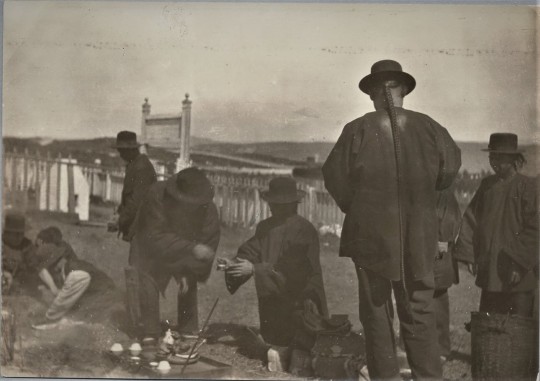
“Ceremony in a Chinese cemetery” no date. Photographer unknown (from the collection of the California Historical Society). According to Woody LaBounty of the Western Neighborhoods Project, the location was probably the San Francisco cemetery in what is now the city’s Lincoln Park and golf course. Amidst the solemnity of the ritual offering, the absence of women from this haunting photo is palpable, as the men of the Exclusion era’s bachelor society venerate another departed pioneer of Chinese California.
When historian Thomas Chinn described Qingming as practiced by the “older generation” in 1989, he might not have foreseen its continued vitality as Chinese from the mainland, Taiwan, Hong Kong, Macau, Malaysia, Singapore, Indonesia, Thailand, Malaysia, and Singapore would continued to emigrate to the US. Wherever the diaspora calls home, they continue to celebrate the “festival” in much the same manner as the Chinese pioneers of California.

Chinese men making offerings of food, wine and incense probably in the Chinese cemetery in Colma CA. Photographer unknown (from the collection of the Bancroft Library).
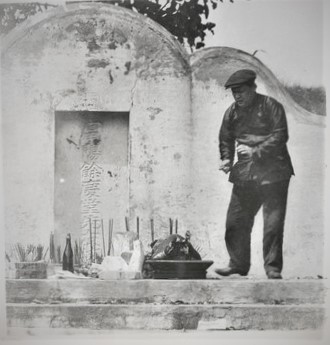
A close up of the offerings placed on the funerary platform and cenotaph probably at a Chinese cemetery in Colma, CA, c. 1890 - 1900. (Photograph by Louis J. Stellman, from the collection of the California Society of Pioneers and the Bancroft Library).
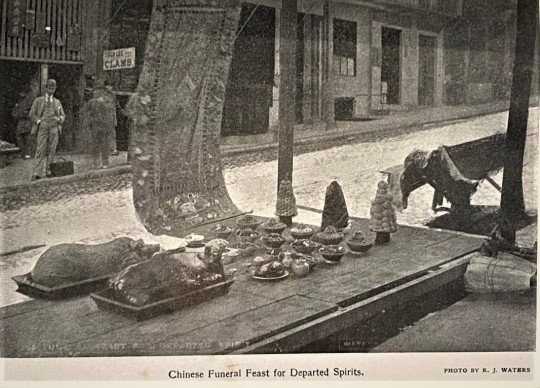
“Chinese Funeral Feast for Departed Spirits,” no date. Photograph by R.J. Waters. Local historian Art Siegel has identified the approximate location of this offering as across from Yuen Lee clam store at 719 Sacramento Street, based on a news item in the Daily Alta California of January 19, 1892:


Chinese and San Francisco’s Early Cemeteries
The annual veneration of ancestors during Qingming inevitably prompts questions about the early history of Chinese burials within the city limits of San Francisco at cemeteries such as the pioneer Yerba Buena Cemetery, Lone Mountain/Laurel Hill Cemetery, and the city’s cemetery once located on the grounds of today’s Lincoln Park. Much of the history remains obscure, but a master’s thesis by Kari L. Hervey-Lentz in 2022, titled “Remaking an Unmade Cultural Landscape: Mapping the Space and Exploring the Meaning of San Francisco’s Historical Cemeteries,” has made a major contribution to local understanding of early cemetery usage by the city’s pioneer Chinese community.
The first Chinese settlers in San Francisco community laid their deceased members to rest in Yerba Buena Cemetery. According to an early account, they occupied a separate area, distinct from the Christian burial section in Yerba Buena, which was described in one newspaper as a "strange looking place" used for the performance of their unique “genius and custom of their Pagan faith.” (J.L., 8 March 1857).
Yerba Buena Cemetery ceased burials in 1854, and the populace, including the Chinese, gravitated toward the Lone Mountain Cemetery. Newspaper accounts indicate that Chinese burials were already occurring at Lone Mountain by 1857 (citing California Farmer and Journal of Useful Sciences, 18 December 1857).

“A Chinese Funeral in Lone Mountain Cemetery, San Francisco, California,” drawn by Paul Frenzeny and published in the Harpers Weekly of January 28, 1882.
According to Hervey-Lentz, Chinese merchants in the city contributed to the construction of a receiving vault at Lone Mountain during the Fall of 1860. This vault served as a temporary resting place for prominent members of the Chinese community upon their passing, where various rituals were conducted. At its peak usage during the 1860’s, the vault held between 150 to 200 bodies at a time before their remains were repatriated to China. The Chinese community’s use of the vault proved short-lived.

“The old Chinese vault” sketch from the San Francisco Chronicle of March 25, 1888. Artist unknown.
Growing anti-Chinese sentiments forced the relocation of the interment space to the western edge of the cemetery. Hervey-Lentz’s research of contemporary news accounts from the 1880’s identified this area, now roughly bounded today by Arguello Boulevard on the west, California Street on the north, Palm Avenue [east], and Euclid Avenue (south), became the resting place for Chinese remains.In describing this relocation, one newspaper (Daily Alta California, February 8, 1877) noted the shifting circumstances, stating that the Chinese “were deprived of the privileges of interring in Laurel Hill Cemetery” and subsequently relegated to a “narrow space” near Lone Mountain. This confined area, according to Hervey-Lentz, quoting from the Daily Alta California of November 25, 1863, “likely references land on the western slope of the cemetery that the Lone Mountain Cemetery Association had granted to the Chinese Six Companies (Hop Wo Company, San [sic] Yup Company, Yong Wo Company, Sze Yup Company, Ling [sic] Yung Company, and Gin Wo Company) in 1863.
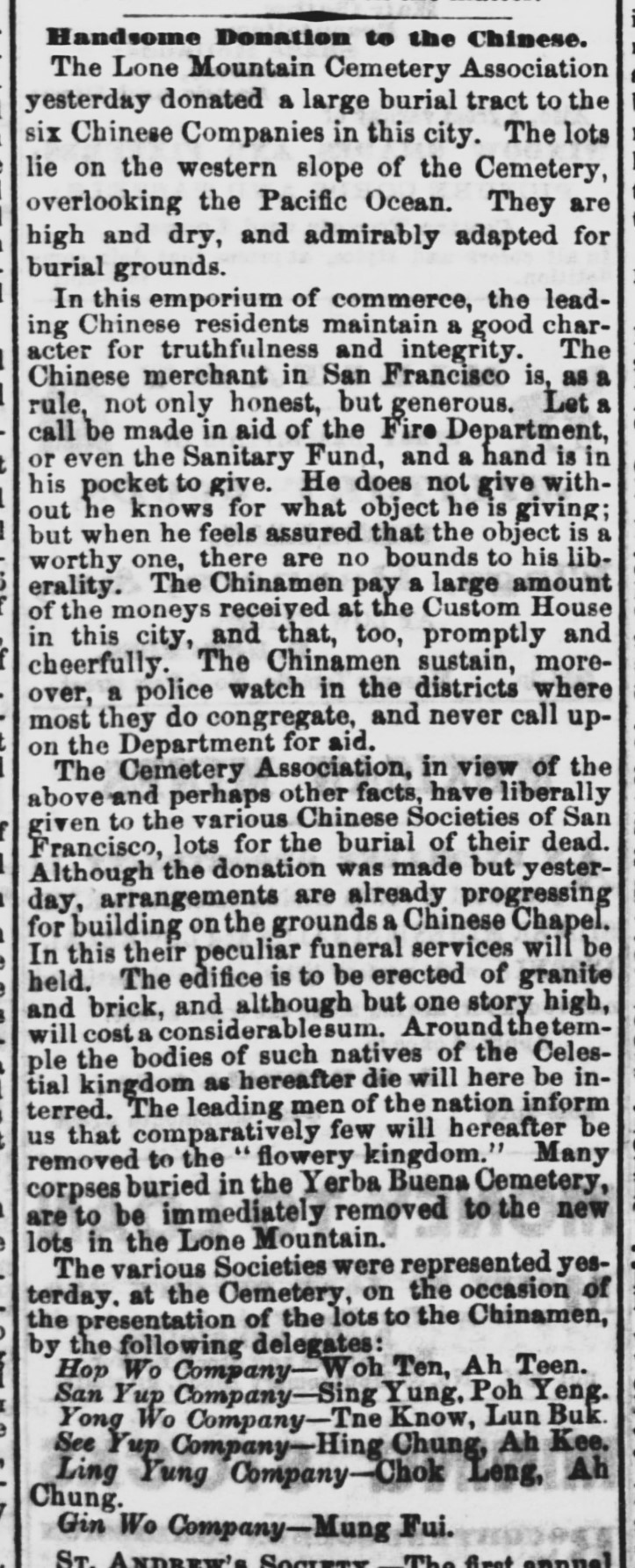
“Handsome Donation to the Chinese,” as reported in the Daily Alta California of November 25, 1863.
A newspaper article in the San Francisco Chronicle of March 25, 1888, included a sketch of the vault and mentioned that, after the Chinese community abandoned it, the structure served as a storage shed and tool shop for the cemetery groundskeepers. This information allowed for Hervey-Lentz to identify a tool shop building on a map from 1895, matching the architectural features of the vault depicted in the newspaper sketch. The structure measured approximately 40 feet in length by 24 feet in width, and there were graded pathways leading to its east-facing entrance. Notably, historical accounts indicate that Chinese funeral processions typically involved horse-drawn carts, making these pathways convenient for their ceremonies.
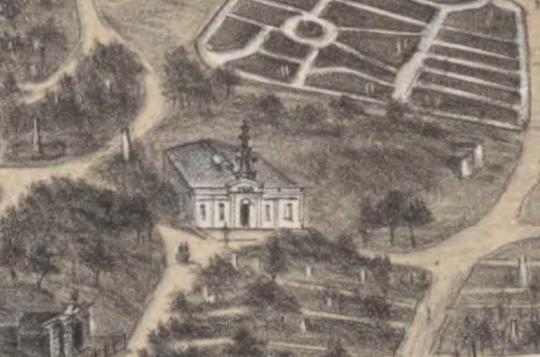
Lone Mountain Cemetery, San Francisco” c. 1866. Lithograph by Charles B. Gifford (from the collection of the Bancroft Library). The lithograph shows some of the architectural features of the central entrance, including its columns that flank two sunken panels. According to Kari Hervey-Lentz, “the structure was about 40 feet long by 24 feet wide and there would have been graded pathways that led to its east-facing entrance. . . . The structure in the 1866 image was embellished with an arched gable above the door in the Italianate style. However, Gifford identified the building as ‘other’ by drawing a fantastical and spindly pagoda on top of the structure. Although it is possible that the ornate pagoda structure was taken down before the 1885 sketch was made, the lack of other images showing this elaborate building within the cemetery coupled with the anti-Chinese sentiment of the time point towards Gifford’s 1866 embellishments as invention.”
The Chinese vault would survive into the next century. During the 1930’s, the renowned photographer Ansel Adams photographed the vault among other photos taken of the Laurel Hill Cemetery's architecture.

The entrance to the Chinese mausoleum in Laurel Hill Cemetery, San Francisco, c 1935-1936. Photograph by Ansel Adams and print prepared for his 1936 one-man exhibition at Stieglitz’s gallery An American Place—including Architecture, Early California Cemetery. Adams' photograph showcases striking architectural details of the building.
Kari Hervey-Lentz writes about Ansel Adams’ photo as follows:
“The image shows the bold architecture of the building, including an arch with sunray-like beams over the entryway. Niches with ornate arched lintels and protruding sills are captured, exactly matching the 1888 newspaper sketch. . . .Understanding that this image depicts Chinese-built architecture, and that within the architecture took place deeply meaningful spiritual and cultural practices to Chinese communities of San Francisco, provide an important context.”
Hervey-Lentz’s research about the chronology and destinations for Chinese mourners and officiants provide welcome context for the images of Chinese funeral processions of the 19th century.
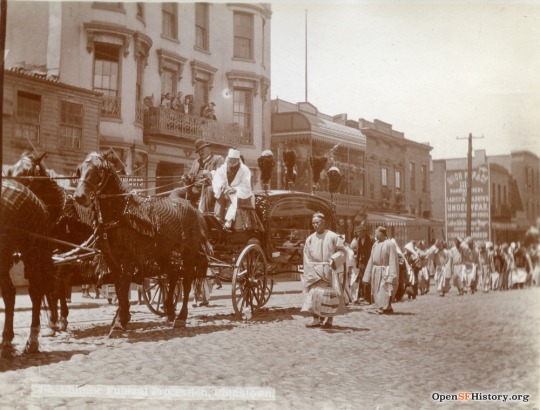
Chinese Funeral Procession, Chinatown. Stockton near Pacific circa 1895 -- photographer J.S. Wooley (Courtesy of a Private Collector). This photo captured a view northwest across 1100 block of Stockton Street between Jackson and Pacific showing the west side of the street. A funeral procession with horse-drawn hearse leads mourners walking in the street. Quen Hop (or Quon Hop) underwear factory 1119 Stockton, appears in the background at right.
Jesse Brown Cook (1860-1938) served the San Francisco Police Department from the late 1880s to the 1930s. He began as a beat officer, and then served as a sergeant of the “Chinatown Squad.” He served as Chief of Police after the 1906 earthquake, retired, and was later appointed to the Police Commission. In his memoirs, Cook wrote about various aspects of the 19th century Chinese in the city and their customs, including funerary rites and the observance of the Qingming festival in the Chinese section of the cemetery out near the city’s Land’s End as follows:
“When I was a boy it was a great treat to go out to the Chinese burying grounds, now known as Lincoln Park. It was a long journey out there -- a long and a solemn one for the Chinese. The Chinese buried their dead in great state. They brought out choisest [sic] cooked foods for the dead to eat before they left the earth (the tramps and birds could be seen eating this later). As the procession moved through the cemetery they threw into the air small pieces of paper with holes. It was believed that the Devil or Evil Spirits had to pass through each little hole before reaching the spirit of the dead. Thus they could beat the Devil and get the body buried first so the Devil could not reach it.”

The few surviving cemeteries of Chinese California comprise part of the dwindling physical legacy of the Asian pioneers on the American frontier. Most Chinese were interred in segregated and often forgotten graves.

Re-touching gravesite information on markers at a Chinese cemetery (probably in Colma, CA) c. 1900. This photograph by Louis Stellman appears in Richard Dillon’s 1976 book for the Book Club of California, Images of Chinatown - Louis J. Stellman’s Chinatown Photographs.
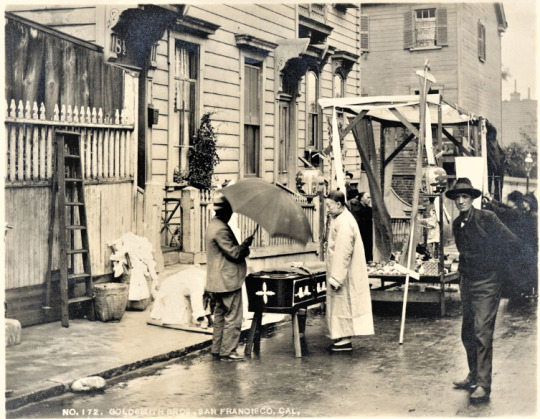
View of a casket resting on a support in a street, wagon parked beyond; several men standing nearby; Chinese funeral preparations in San Francisco, Cal. Photograph by Goldsmith Bros. (from the collection of the California State Library).
The tourist travelogues of the late 19th century expressed constant fascination with the social fabric of old San Francisco Chinatown. The quality of such accounts varies widely, ranging from the profoundly ill-informed, or even racist, to the sometimes scholarly. Tourists to pre and post-1906 Chinatown often saw funeral rites conducted in the streets and recorded their obsersations. In an article published by The Pacific Tourist in 1878, F.E. Shearer wrote about Chinese funerary practices as follows:
“The funerals are conducted with great pomp. The corpse is sometimes placed on the sidewalk, with a roast hog, and innumerable other dishes of cooked food near it, when hired mourners with white sheets about them, and two or three priests as masters of ceremony, and an orchestra of their hideous music, keep up for hours such unearthly sounds as ought to frighten away all evil spirits.
“The wagon-load of food precedes the corpse to the grave, and from it is strewn “cash,” on paper to open an easy passage to the “happy hunting grounds” of the other world.
“’Ancestral Worship’ is the most common of all worship among the Chinese. Tablets may be seen in stores, dwellings and rooms connected with temples. Its origin is shrouded in mystery. One account derives it from an attendant to a prince about 350 B.C. The prince while traveling, was about to perish from hunger, when he cut a piece of flesh from his thigh, and had it cooked for his master, and perished soon after. When the prince found the corpse of the devoted servant, he was moved to tears, and erected a tablet to his memory, and made daily offerings of incense before it. Other absurd stories of filial devotion are told for the same purpose.
“The ancestral tablet of families, varies from two to three inches in width, and 12 to 18 in height, and some are cheap and others costly. There are usually three pieces of wood, one a pedestal and two uprights, but sometimes only two pieces are used. One of the upright pieces projects forward over the other from one to three inches.
“One tablet can honor only one individual, and is worshiped for from three to five generations. To the spirit of ancestors a sacrifice of meats, vegetables, fruits, etc., is often made with magnificence and pomp, and the annual worship of ancestral dead at their tombs, is of national observance, and occurs usually in April, and always 10 days after the winter solstice. . . .
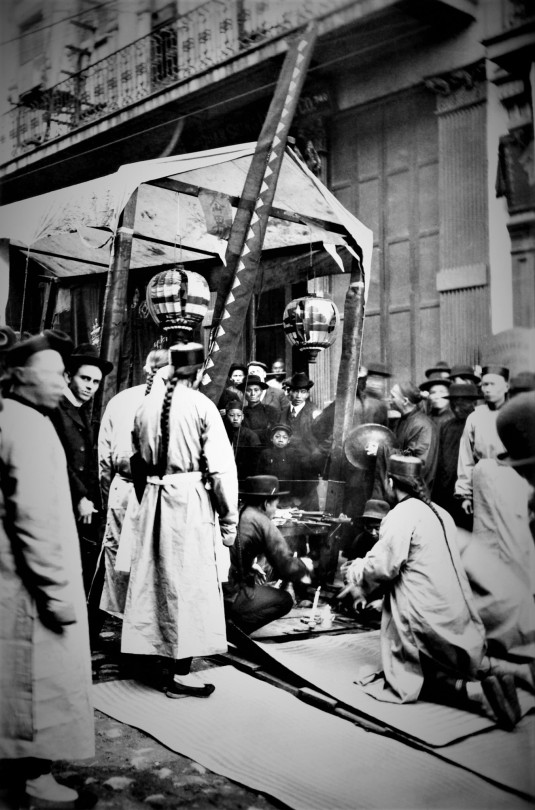
Dupont Street funeral, c. 1895. Photographer unknown (from a private collection).
“The offerings are more plentiful than the meats at a barbcue in the Far South, carcasses of swine, ducks, chickens, wagon-loads of all sorts of food and cups of tea, are deposited at the graves; fire-crackers continually exploded, and mock money and mock clothing freely consumed. All kneel and bow in turn at the grave, from the highest to the lowest.
“As in the case of the gods, the dead consume the immaterial and essential elements, and leave the coarse parts for the living. Unlike the gods, the dead consume ducks. ‘Idol no likee duck, likee pork, chicken, fruits.’”
-- from Shearer, F.E., “The Chinese in San Francisco,” The Pacific Tourist, (Henry T. Williams pub., 1878), p. 323.
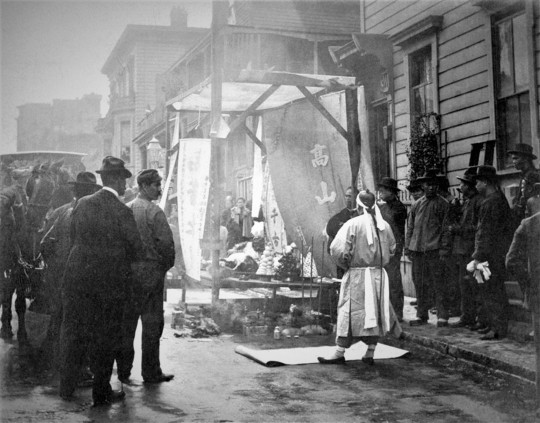
“Street Scene” of a funeral in San Francisco CA. No date. Photographer unknown (from the collection of the Bancroft Library)

A funeral parade on Dupont Street, c. 1900. Photographer unknown (from a private collection). The signage of the mercantile house, Sing Fat & Co., at 614 Dupont can be seen in the left of the photo.
As the presence of Chinese in North America lengthened, the various family and district associations assumed the responsibility for providing funeral and burial services on tracts of land devoted for Chinese use, including the construction of funerary incinerators and the appropriate positioning of grave plots according to feng shui (風水) principles.
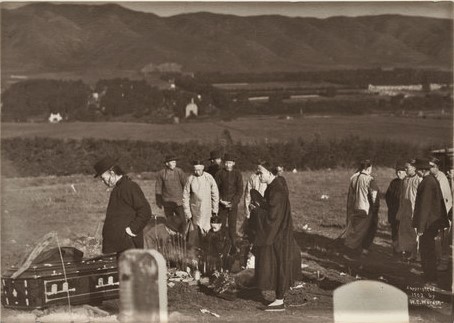
The above photo appears to depict a funeral in Colma, California, c. 1903. Photographer unknown (from the collection of the Bancroft Library). The absence of women from the photo is palpable, as the men of the Exclusion era’s bachelor society lays to rest another pioneer of Chinese California.
Away from the major settlements, however, and in the smaller towns of the Sierra foothills, the cemeteries established by small Chinese communities eventually fell into disuse and decay, as Chinese were driven off or drifted back to the cities.

A Chinese funeral procession in Dutch Flat, CA.
Today, the discovery of Chinese graves often occurs during large-scale construction projects in areas that were settled during the mid-19th century. In 2005, the construction of the Metro Gold Line Eastside Extension revealed 174 unmarked Chinese graves in Boyle Heights.
In the Boyle Heights case, the LA Times reported in 2010 that all the bones and artifacts were reinterred inside Evergreen Cemetery which had originally banned Chinese interments. About 1,400 Chinese were believed to have been buried in the Boyle Heights potter’s field. According to the Times, and despite an outreach effort, the MTA was unable to identify any living relatives of the Chinese whose remains were uncovered during the digging for the Gold Line extension.

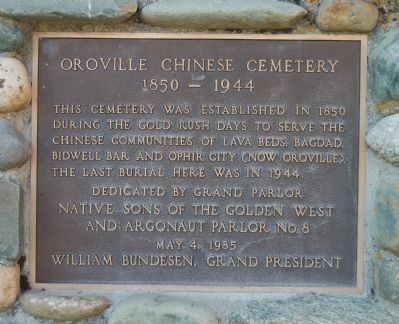
The Chinese who helped build California were forbidden to marry or own property, and they were generally barred for decades from using the secular burial grounds that served the state’s cities and towns. Moreover, the Chinese practice of unearthing bones for shipment back to the deceased’s ancestral village (as seen in the photo below); the practice complicated the maintenance of grave markers and even the identification of the locations of Chinese graves over subsequent decades.

Bone pickers in Colma CA.

“Cleaning the Bones of the Dead” (after disinterment) from “Chinese Life in San Francisco” engraving published in Harper’s Weekly, c. 1879. Illustrator unknown.
The cemeteries of Chinese California and elsewhere in the American West represent part of the vanishing physical legacy of the Chinese pioneers in far-flung rural communities. Many have only markers to show the locations of long-deceased ancestors.

Borden CA

A Chinese cemetery in Los Angeles CA, c. 1900. The funerary burner bears the date of September 1886. Location and photographer unknown from the California Historical Society Collection at the University of Southern California.
Conventional historical accounts assert that the practice of disinterring remains for shipment back to the ancestral villages in China continued in North America at least up to the 1949 communist victory in the Chinese civil war. The growth of families in the US, however, also induced many Chinese families to bury deceased family members in permanent plots in America, presumably to facilitate veneration of ancestors in the US.
Regardless of the changes in the ultimate disposition of ancestral bones, large funeral processions continued to represent significant occurrences on the Chinatown streetscape. My great grandmother’s death in December 1922 presented a notable and exceptional example of a community-wide honor to a woman. Contrary to the news report about the family’s original intent to send her bones to China, my great grandmother’s remains were permanently located in Olivet Cemetery in Colma CA.

As the above clipping from the San Francisco Examiner of December 25, 1922, attests, the rites and funeral procession for my great grandmother Hee Ching She (erroneously named “Chuck How” in the news article), made the news for its size and hundreds of women attendees.

The all-women head of the funeral procession for Mrs. Hee Ching She in San Francisco Chinatown on December 24, 1922.

The San Francisco Examiner reported that the December 24, 1922, funeral procession for Mrs. Hee Ching She “strung along for three city blocks, the women halted first in front of the decedent’s home, 620 Clay street, then again in front of the home of the [actually younger] son, at 705 Kearny street, finally disbanding at the corner of Pine street and Grant avenue.”

The southbound funeral procession of prominent businessman Chin Bok Lain (1869 - 1938) as viewed from the balcony of the Hang Far Low restaurant overlooking Grant Avenue toward the intersection of Grant and California Street at the top of the photo. A brief account of Chin’s life by his descendant, Kenneth J. Hong, may be read here.
The acceleration of Chinese American family formation and growth because of the enactment of the War Brides Act and the Immigration Act of 1965 also strengthened the practice of permanently locating and venerating ancestral graves in communities across North America.
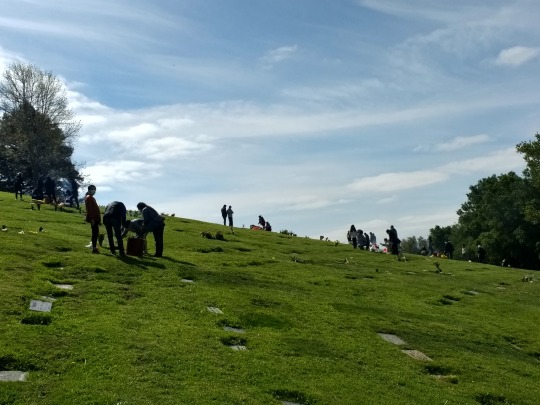
Families present offerings and burn paper money for their ancestors in the Chinese section of the Mountain View Cemetery in Oakland CA, on Qing Ming or Tomb Sweeping Festival day in 2021. (Photo by Doug Chan)
Although terrain may vary, the old rules of grave location, e.g., south to a hill or north toward water in front of the grave, and ideally with a “mountain behind and luxuriant plants around” remain desirable. Over the course of events during the 20th century, Qing Ming became, and remains, a very Chinese American day of remembrance.
[updated 2024-4-14]
#Qing Ming#Tomb Sweeping Day#Thomas W. Chinn#Chinese funerals#Chinese cemeteries#Yuen Lee clam store#Lone Mountain Cemetery#San Francisco Chinatown#Dutch Flat#Hee Ching She#Ansel Adams#Laurel Hill Cemetery#Yerba Buena Cemetery#Jesse B. Cook
6 notes
·
View notes
Text
清明節
I feel like such a shitty Chinese person today. It's Qingming Festival [today] and I don't even know where tf my grandparents are buried, aside from the fact their graves are somewhere in New Jersey.
I don't even have the traditional offerings and incense to burn to pay my respects.
3 notes
·
View notes
Photo

牌九大贏家
牌九大贏家
Game 牌九大贏家 là dòng game Board
Giới thiệu 牌九大贏家
牌九,是中国傳統骨牌游戏,玩法是依據兩扇骨牌點數的不同組合,來比較大小,以決定勝負。 【各牌名稱】 在32隻牌當中,有11種牌有兩隻.這種成雙的牌稱文牌 或文子。 1.天牌:紅6點,白6點,兩支牌共24點,象徵天候的二十四節氣,文牌中最大的牌。 2.地牌:紅2點,兩支牌共4點,象徵大地東南西北4個方位。 3.人牌:紅8點,兩支牌共16點,象徵仁義忠信、禮智廉恥、是非羞惡、惻隱辭讓十六項为人处事之道德。 4.和牌、鵝牌、 爺:紅1點,白3點,狀似鵝,故有此稱呼。兩支牌共8點,象徵大和元氣流通八節(春節、元宵、清明、端午、中元、中秋、重陽、冬至),表示四海昇平,國泰民安。 5.梅花、梅牌:白10點,狀似梅花,故有此稱呼。 6.長三、長牌、長衫:白6點 7.板凳:白4點,四點状似板凳四腿,故有此稱呼。 8.斧頭、虎頭:白11點 9.紅頭、紅頭十、屏風:紅4點,白6點 10.高腳七:紅1點,白6點 11.伶冧六、銅��、銅錘六:紅1點,白5點 ,形狀仿如一柄銅錘,又仿如一朵伶仃的花冧(花蕾),文牌中最小的牌 在32隻牌當中,有10隻牌沒有成雙。其中8隻有點數相同,但圖案不同的「對應牌」。而2種只有單獨一隻。這種牌共有10隻,稱武牌 或武子。 1.雜九、紮九、武九:有兩種,一紅4點白5點,一白9點,武牌中最大的牌 2.雜八、紮八、武八:有兩種,都是白8點,但排列方式不同 3.雜七、紮七、武七:有兩種,一紅4點白3點,一白7點 4.雜五、紮五、武五:有兩種,一紅5點,一白5點 5.二四、大头六、大鸡、大鸡六、雜六、紮六 、武六:至尊牌之一, 紅4點,白2點,可當3用 (廣東牌九玩法) 。 6.么鸡、么鸡三、丁三、丁鸡、细鸡、雜三、紮三、武三:至尊牌之一, 紅1點,白2點,武牌中最小的牌,可當6用 (廣東牌九玩法) 。 【玩法】 骨牌牌九的基本玩法就是以骨牌點數大小分勝負。骨牌牌九又分大牌九與小牌九,大牌九是每人四张牌,分为大小两组,分别与庄家比牌,全胜全败为胜负,一胜一败为和局;小牌九是每人两张牌,胜负立现,由於干脆利落,小牌九於民間流行較广。 【對牌大小順序】 對牌或称對子,是成对的二牌。以下列的是所有对牌大小顺序。但算不算对牌因地域而異。例如,天王、地王、天槓、地槓、天高九及地高九等,有些地域并不列为对牌,尤其是天高九及地高九。 1.至尊宝,猴王對,皇帝,至尊天九:丁三配二四,歇後語“丁三配二四──绝配”由此而來,特点是点数3+6=9。二牌单牌点数很小但对牌最大,这就是可玩味之处。 2.雙天,天托:由两天牌组成 3.雙地,地托:由两地牌组成 4.孖人,人托:由两人牌组成 5.孖和,和托,孖鵝,爺托:由两和牌组成 6.孖梅,梅托:由两梅花牌组成 7.孖長,长托:由两长三牌组成 8.孖板凳:由两板凳牌组成 9.孖斧头:由两斧头牌组成 10.孖紅頭:由两紅頭牌组成 11.孖高腳:由两高腳七牌组成 12.孖零霖:由两零霖六牌组成 13.雜九,紮九寶,武九:由两雜九牌组成 14.雜八,紮八寶,武八:由两雜八牌组成 15.雜七,紮七寶,武七:由两雜七牌组成 16.雜五,紮五寶,武五:由两雜五牌组成 17.天王:天牌配任何一種9點牌,即天牌配杂九牌,特点是点数为12+9=21,算个位数是1 18.地王:地牌配任何一種9點牌,即地牌配杂九牌。特点是点数为2+9=11,算个位数是1 19.天槓,天牌八,天貫:天牌配任何一種8點牌,即天牌配人牌或杂八牌。特点是点数为12+8=20,算个位数是0 20.地槓,地牌八,地貫:地牌配任何一種8點牌,即地牌配人牌或杂八牌。特点是点数为2+8=10,算个位数是0 21.天高九:天牌配任何一種7點牌,特点是点数为12+7=19,算个位数是9 22.地高九:地牌配任何一種7點牌,特点是点数为2+7=9,算个位数是9 若沒有以上的對牌,則以二牌之和的個位數分勝負.最大是9,最小是0。这也是牌九的名称由来,即排出九的数目之意。 【免責條款】 遊戲以成年人為訴求對象 遊戲不提供“現金交易賭博”,也沒有機會贏得現金或實體獎品 在遊戲中的練習狀況或成就,不代表日後在“現金交易賭博”中會獲得成功 Pai Gow, a traditional Chinese domino game, is played based on different combinations of two domino points to compare the size to determine the outcome. [Name of each brand] Among the 32 cards, there are 11 kinds of cards and two of them. This pair of cards is called a wen or zi. 1. Sky card: 6 points in red and 6 points in white. The two cards have a total of 24 points, symbolizing the twenty-four solar terms of the weather, and the largest card in the card. 2. Land cards: Red 2 points, two cards with a total of 4 points, symbolizing the 4 directions of the southeast and northwest of the earth. 3. People card: Red 8 points, two cards with a total of 16 points, symbolizing benevolence, loyalty, honesty, wisdom, shame, right and wrong, shameful resignation, let the sixteen people act as morals. 4. Hip, goose, and grandfather: Red 1 point, white 3 points, looks like a goose, so it is called this. The two cards have a total of 8 points, which symbolizes the eight festivals of the flow of the Yamato Yuan (Spring Festival, Lantern Festival, Qingming Festival, Dragon Boat Festival, Dragon Boat Festival, Mid-Autumn Festival, Mid-Autumn Festival, Chongyang, Winter Solstice), which means that the four seas are leveled, and Guotai Minan. 5.Plum blossom, plum card: white 10 o'clock, looks like plum blossom, so it is called this. 6. Long third, long card, long shirt: white 6 o'clock 7. Bench: 4 o'clock in white, the four-point shape resembles the bench's four legs, hence the name. 8. Axe, tiger's head: white 11 o'clock 9. Red head, red head ten, screen: red 4 points, white 6 points 10. High Feet Seven: Red 1 and White 6 11. Lingding VI, Bronze Hammer, Bronze Hammer VI: Red 1 point, white 5 points, the shape is like a copper hammer, and it is like a Linghua flower bud (flower bud), the smallest card in the card. Of the 32 cards, 10 are unpaired. 8 of them only have "corresponding cards" with the same points but different patterns. There is only one of the two types. There are a total of 10 such cards, called martial arts cards or martial arts. 1. Miscellaneous, Zhajiu and Wujiu: There are two types, one red, four points, white five points, and one white nine points. 2. Zhaba, Zhaba and Wuba: There are two types, both of which are 8 o'clock in white, but the arrangement is different. 3. Miscellaneous Qi, Zha Qi, Wu Qi: There are two types, one red, four white, three white, and one white seven. 4. Miscellaneous Wu, Zha Wu, Wu Wu: There are two types, one red 5 points, one white 5 points 5. Twenty-four, big head six, big chicken, big chicken six, miscellaneous six, tie six, martial arts: one of the supreme cards, red 4 points, white 2 points, can be used as 3 (Guangdong Pai Gow) 6. Mochi, Mochi3, Dingsan, Dingji, Fine Chicken, Miscellaneous, Zhasan, Wusan: one of the supreme cards, red 1 point, white 2 points, the smallest card in the martial arts, can be 6 Use (Guangdong Pai Gow). [How to play] The basic game of dominoes is to win and lose with domino points. Dominoes are divided into big cards and small cards. Big cards are four cards per person. They are divided into two groups. They are compared with the dealers. With two cards per person, the winner and the loser stand out. Due to the clear cut, the small card is popular in the folk. [Sequence of pairs of cards] A pair of cards or pairs is a pair of two cards. The following is the order of all pair sizes. But whether they are right or not varies by region. For example, King of Heaven, King of Land, Sky Bar, Ground Bar, Sky High Nine and Earth High Nine, etc., some regions are not listed as pairs, especially Sky High Nine and Earth High Nine. 1. Extreme Treasure, Monkey King Pair, Emperor, Supreme Heaven Nine: Ding San matches two four, and the rest of the phrase "Ding San matches two four-perfect match" comes from it, which is characterized by points 3 + 6 = 9. The second card single card has a small number of points but the largest pair, which is where the fun comes from. 2. Double days, day care: composed of two days cards 3. Double land, ground care: composed of two land cards 4. Puppet, support: composed of two cards 5. Hehe, He Tuo, Lao Goose, Ye Tuo: Consisting of two ties 6. Pumei, Meto: Composed of two plum cards 7. Long and long care: consisting of two long and three cards 8. 孖 bench: composed of two bench cards 9. Axe: composed of two axe cards 10. 孖 Red Head: Composed of two red head cards 11. High-footed: consisting of two high-footed seven cards 12. Lingling Lin: Consisting of two Linglin and six cards 13. Miscellaneous Jiu, Zha Jiubao, Wu Jiu: Composed of two miscellaneous nine cards 14. Miscellaneous Eight, Zha Babao, Wu Ba: Composed of two miscellaneous eight cards 15. Miscellaneous Seven, Zhaqibao, Wuqi: Composed of two miscellaneous seven cards 16. Miscellaneous Wu, Zhawubao, Wuwu: Composed of two miscellaneous five cards 17. King of Heaven: Tian card with any kind of 9-point card, that is, Tian card with miscellaneous nine cards. The characteristic is that the number of points is 12 + 9 = 21, and the single digit is 1. 18. Land King: Land cards are matched with any kind of 9-point card, that is, land cards are matched with miscellaneous nine cards. The characteristic is that the number of points is 2 + 9 = 11, and the number of single digits is 1. 19. Sky bar, sky card eight, sky pass: The sky card is matched with any kind of 8-point card, that is, the sky card is paired with a person card or a miscellaneous eight card. The characteristic is that the number of points is 12 + 8 = 20, and the number of single digits is 0. 20. Land bars, land cards eight, land passes: Land cards are matched with any kind of 8-point cards, that is, land cards are paired with people cards or miscellaneous eight cards. The feature is that the number of points is 2 + 8 = 10, and the number of digits is 0. 21. Tian Gao Jiu: Tian card is equipped with any kind of 7-point card, the characteristic is that the number of points is 12 + 7 = 19, and the single digit is 9 22. Land High Nine: Land cards are equipped with any kind of 7-point cards. The characteristic is that the number of points is 2 + 7 = 9 and the single digit is 9 If there is no above pair of cards, the single-digit points of the sum of the two cards will be the winner. The maximum is 9, and the minimum is 0. This is also the origin of the name Pai Gow, which means that the number of nines is excluded. 【Disclaimer】 Games target adults The game does not offer "cash trading gambling" and there is no chance to win cash or physical prizes Practice status or achievement in the game does not mean that you will succeed in "cash trading gambling" in the future 優化登入及遊戲房間鏈接異常問題
Download APK
Tải APK ([app_filesize]) #gamehayapk #gameandroid #gameapk #gameupdate
0 notes
Photo

In the era of the Cold War, walking down Xinsheng South Road He remembers that fiery war, a furnace, of resistance remembers Marco Polo Bridge, roaring, all the lions on the bridge, at Samurai swords, sakura Samurais across the waters “The Great Wall is ten thousand miles long, outside the Great Wall— is the old home”[1], remembers how, a nation, grinded and exiled in the same melody from Shanhai Pass to Shao Pass[2]. His home is in the Great Wall, no, south of Changjiang, but that ditty, every time, it leaves his heart soured, his nose sore “The Great Wall is ten thousand miles long, outside the Great Wall is—” song, was an ordinary song; extraordinary was the era of singing, a people that sang together was exiled together, in a little town at the back one thousand reminders, one thousand drumbeats whose reminders was the postmark beating against? Two faces to the years in exile the front, a postage stamp, the back, a train ticket An old song, an illumination flare a memory from twenty years ago, suddenly, spotlighted In the era of the Cold War, walking down Xinsheng South Road He remembers, in that concert, barely just seventeen years of age, at most eighteen, that girl who was not yet born, in the era he had sung in Tonight those listeners, half of them, were not yet born They have no idea the British concession, Japanese concession, Burma Road, Youth Army, straw sandals, cheap rice grains, straw sandals empty and hollow, years spent in shelter hollows, “bright moonlight illuminates his hometown”, moonlight aside, the foreign bombs' firelight power cut night, the night before the blitz, was like that also that one gala night, was like that also Such a cute, such a clever girl singing the same song, sang it badly, still it moved him to tears “Don’t be sad”, smiling, she said, “The moon is really pretty, I want you to walk me home” Later she wore his ring a pair of eyes that loved smiling, like stamps, pressing upon Tingting and Yaoyao’s cheeks That was somehow— recalling details of many years ago July 7th in the Heavens, July 7th on Earth[3] her grave on Mount Guanyin, across freshwater shores last year’s Qingming Festival, and the Qingming before that Walking down Xinsheng South Road, in the era of the Cold War He remembers, a cold and empty apartment an old double bed waiting for him to go home “The moon is really pretty, I want you to walk me home” Remembers how, the ancestors’ graves are on the Mainland the wife’s grave is on the island, Yaoyao and Tingting both gone, leaving him all alone three generations segregated into three, no, four worlds Ten thousand miles of Great Wall, ten thousand miles of solitary drift, the moon is really pretty, he says as he walks down Xinsheng South Road, in the era of the Cold War
Read more below to see my translation notes and a transcript of the original Chinese version of the poem.
Translation notes:
This is the Ballad of the Great Wall, a song sung by patriots during the Second Sino-Japanese War.
Shanhai Pass and Shao Pass are both gates in the Great Wall.
July 7th is the Chinese Valentines Day, in the origin story the lovers that die on 7th July are canonized, living forever “in the Heavens”. July 7th also refers to the July 7th Incident, also known as the Marco Polo Bridge Incident.
I drafted the first version of this translation as part of one of my portfolios submitted under the Warwick Writing Programme. It is based as faithfully as I can manage on "在冷戰的年代”, poem by my favourite late Chinese poet, Yu Guangzhong.
When I translated the poem, I aimed to maintain its major characteristics: the overwhelming sense of melancholy, and its purpose as a stream-of-consciousness memoir illustrating the speaker’s experiences in and after the Second Sino-Japanese War. The use of enjambment is carried over from the original poem, which helps to ease the transitions between memories of different time periods. Nevertheless, some elements of the poem are lost in translation, as the Chinese language is much richer with implications. Each word consists of two or more characters, and each character on its own may contain several denotations. As such, a single word in Chinese may contain a lot more emotive implications than in English. Therefore, the subtle air of self-pity present in the original poem is watered down to mere melancholy after translation.
Still, at the suggestion of my course tutor at the time, I tried to keep the translation literal, so that elements like repetitions and polyptotons can be carried over via the construction of unconventional imagery. To this end, I have recently revisited my translation and updated some of the phrases to keep it even more literal and stripped down, so as to let the content speak for itself. In the line, “Two faces to the years in exile,” an earlier version of the translation I used the word “sides” instead of “faces”; but, the original poem really used the words “面貌”, which means “appearance” or “face”, so I kept that. As another example, the phrases, “it leaves his heart soured, his nose sore” are more or less literal translations of two common Chinese expressions associated with grief and sadness.
The image used for the cover artwork is by Diego Jimenez on Unsplash.
The original poem:
在冷戰的年代 余光中
在冷戰的年代,走下新生南路 他想起那熱戰,那熱烘烘的抗戰 想起蘆溝橋,怒吼,橋上所有的獅子 向武士刀,對岸的樱花武士 “萬里長城萬里長,長城外面—— 是故鄕”,想起一個民族,怎樣 在同一個旋律裏咀嚼流亡 從山海關到韶關。 他的家 在長城,不,長江以南,但是那歌調 每一次,都令他心酸酸,鼻子酸酸 “萬里長城萬里長,長城外面是——” 歌,是平常的歌,不平常 是唱歌的年代,一起唱的人 一起流亡,在後方的一個小鎮 一千個叮嚀,一千次敲打 郵戳敲打誰人的叮嚀 兩種面貌是流亡的歲月 正面,是郵票,反面,是車票 一首舊歌,一枚照明彈 二十年前的記憶,忽然,被照明 在冷戰的年代,走下新生南路 他想起,那音樂會上,剛才 十七歲,最多是十八,那女孩 還不曾誕生,在他唱歌的年代 今夜那些聽眾,一大半,還不曾誕生 不知道什麼是英租界,日本租界 滇缅路,青年軍,草鞋,平價米,草鞋 空空洞洞,防空洞中的歲月,“月光光 照他鄉”,月光之外,夷燒彈的火光 停電夜,大轟炸的前夜,也是那樣 那樣一個晚會,也是那樣 好乖好靈的一個女孩 唱同樣的那一只歌,唱得 不好,但令他激動而流淚 “不要難過了”,笑笑,她說 “月亮真好,我要你送我回去” 後來她就戴上了他的指環 將愛笑的眼睛,蓋印一樣 蓋在婷婷和么么的臉上 那竟是——念多年前的事了 天上的七七,地上的七七 她的墓在觀音山,淡水對岸 去年的清明節,前年的清明 走下新生南路,在冷戰的年代 他想起,清清冷冷的公寓 一張雙人舊床在等他回去 “月亮真好,我要你送我回去” 想起如何,先人的墓在大陸 妻的墓在島上,么么和婷婷 都走了,只剩下他一人 三代分三個,不,四個世界 長城萬里,孤蓬萬里,月亮真好,他說 一面走下新生南路,在冷戰的年代
#spilled ink#new poets society#poets on tumblr#poets of color#scheherazadeanpoetry#yu guangzhong#{poetry}#{portfolio}#{Eugenia's archive}
0 notes
Video
youtube
Daily Reco Entry 1114: Two Days Ago
Daily (iso)Reco Entry 1117: Wednesday, April 05, 2017, PM
清明 (Qīngmíng), written for 清明節 (Qīngmíng jié, literally “Qingming Festival”) by 杜牧 (Du Mu), recited by a person
1 note
·
View note
Text
Long Weekend spent in Hualien
This past weekend was a pretty big hype for the Taiwanese locals and expat dwellers in town. It was “Tomb Sweeping Day” aka 清明節 (Chinese) aka Qing Ming Festival. I learned that everybody gets the same time off of work so the traffic is nuts everywhere, and big events happen (Spring Scream Festival in Kenting) around the country. Same time because everyone’s too scared to take vacation days or sick days due to fear of replacement.
What: A national holiday, you get a day off for it. It is one of the oldest holidays on the planet. When: April 5th Why: An important day of sacrifice for most people to go and sweep tombs and commemorate their ancestors. If you want to visit and respect your ancestors, this is the best time to do it. It’s also the time to put down your phones, go outside and start enjoying the greenery of spring. Qingming (清明) is the second of 24 solar terms on the traditional Chinese solar calendar. I didn’t know what it was but I almost stayed home to catch up with myself and work on designs but I saw how beautiful it was out so I decided to hop on board a group of adventurers going to Hualien for 3 days. I’ve never met them before so that was pretty exciting. I let them do all the planning since I’m not familiar with the place and they were.
Day 1 Getting to Hualian
8am We met up at Taipei Main Station at the TRA Station located in B3 which can be found when you go up the escalator from the MRT train.
Follow the signs.

Since there was 4 of us, 1 was in Banqiao where the train starts, 1 got lost trying to find where the TRA platform was. He ended up at the main TRA platform with the checkered floors on Floor 2.
Ticket Cost: $440NT
We took the 8:47am train and got there at 12pm.


Upon arrival, we went to scout some hostels. First place we checked out was Chantai Hotel - 2100/night for 4 people -- private room. Pictures looked pretty rusty so we went across the street to Hualien WOW Youth Hostel.
Hualien WOW Youth Hostel:
Young friendly staff who could speak English pretty well
$600/night per person in a 4 person dorm
$2760/night per person, private room for 4
Breakfast included - probably the best breakfast I’ve had offered in a hostel. Eggs, Ham, Cheese, Toast, Oranges, Tea, Jam, Butter. They don’t keep track how many you take
Has boardgames and books
They offer toothbrush, snacks, tampons, and other things which you can purchase in the lobby by honour system
Very worth it, I’d go again
Right across from the Hualien Train Station
Clean, modern, looks pretty new
Bed was hard but it was your own space, it wasn’t a bunk bed. The room was set up really cool.



Once we were settled, it was too late to take the bus anywhere. Places are 1-2 hour bus rides away unfortunately so we took the bus to the Chishingtan Scenic Area which took 10minutes for $25NT.

Big waves crashing in.


Spent the evening playing boardgames.

#hualien#travel#doge#busrides#hostel#taipeimainstation#tombsweepingday#longweekend#taiwan#taipei#beach#hualienwowyouthhostel#youthhostel
0 notes
Video
youtube
中国の伝統行事「清明節」を迎え、先祖の墓参り Chinese honour loved ones' graves ahead of Qingming festival
0 notes
Text
Holidays 4.4
Holidays
Art Deco Day
Ballroom Dance Day
Basque Day (Spain)
Bonza Bottler Day
Children’s Day (China, Taiwan)
Clear and Bright Day (Farmer’s Calendar; China)
404 Day
Hug a Newsperson Day
Independence Day (Senegal; from France, 1960)
International Day for Mine Awareness and Assistance in Mine Action (UN)
International Day to Defend Amina
Jeep 4x4 Day
Microsoft Day
Mourning Day for Covid-19 Martyrs (China)
National Fun Day [1st Monday]
National Horse Rehabilitation Day
National Lunchbreak Day (UK)
National Pansy Day
National Reading a Roadmap Day (a.k.a. Learn to Read a Roadmap Day)
Ose Matsuri (Japan)
Peace Day (Angola)
Public Library Day [Monday of Library Week]
Sarhul (Jharkhand, India)
School Librarian Day [Monday of Library Week]
Swedish-American Friendship Day
Tell-A-Lie Day
Victims of Violence Wholly Day
Vitamin "C" Day
Walk Around Things Day
World Rat Day
Food & Drink Celebrations
Chocolate Milk Powder Day (a.k.a. Powdered Chocolate Day)
Homogenized Milk Day
International Carrot Day
National Bake Week begins [1st Monday]
National Cordon Bleu Day
National Pub Day (UK)
Sweet Potato Day [1st Monday]
Tater Day (Kentucky) [1st Monday]
Feast Days
Benedict the Moor (Christian; Saint)
Cold Food Festival [Begins 15th Day of Spring Equinox; Ends 4.6] (a.k.a. …
Hanshi Festival (China)
Hansik (South Korea)
Tết Hàn Thực (Vietnam)
Dabucuri pataub, (Initiation Rites of the Young Men; to Jurupari, South American Guarani/Tupi God)
Gaetano Catanoso (Christian; Saint)
Goof Friday (Church of the SubGenius)
Isidore of Seville (Christian; Saint)
Katori Jingu Otaue-sai (Rice Planting Festival; Japan)
Magna Mater begins (aka Megalesia / Great Mother Festival; Ancient Rome)
Martin Luther King Jr. (Episcopal Church (USA))
Nafels Pilgrimage (Glarus Canton, Switzerland)
Reginald Heber (Anglican Church of Canada)
Theodisius of Bithynia (Positivist; Saint)
Tigernach of Clones (Christian; Saint)
Tomb Sweeping Day (掃墳節) [Begins 15th Day of Spring Equinox; Ends 4.6] (a.k.a. …
Ancestors' Day
Chinese Memorial Day
Ching Ming Festival (清明節; China)
Qingming Jie (清明节; China)
Shīmī (Ryukyu Islands)
Lucky & Unlucky Days
Shakku (赤口 Japan) [Bad luck all day, except at noon.]
Unluckiest Day of the Year (China)
Unlucky Monday (when God condemned the towns of Beram, Lipandas, Madama, Sodom and Gomorrah; Philippines) [1st Monday] (2 of 4)
Premieres
Captain America: The Winter Soldier (Film; 2014)
Cool for Cats, by Squeeze (Album; 1979)
Today is Also…
Day of Year: Day 94 of 2022; 271 days remaining in the year
ISO: Day 8 of week 14 of 2022
Celtic Tree Calendar: Fearn (Alder) [Day 18 of 28]
Chinese: Month 3 (Huáiyuè), Day 4 (Ding-Hai)
Chinese Year of the: Tiger (until January 22, 2023)
Hebrew: 3 Nisan 5782
Islamic: 2 Ramaḍān 1443
J Cal: 4 Aqua; Threesday [4 of 30]
Julian: 21 March 2022
Moon: 12% Waxing Crescent
Positivist: 10 Archimedes (4th Month) [Theodisius of Bithynia]
Runic Half Month: Ehwaz (Horse) [Day 7 of 15]
Season: Spring (Day 16 of 90)
Zodiac: Aries (Day 15 of 30)
0 notes
Text
Holidays 4.4
Holidays
Art Deco Day
Ballroom Dance Day
Basque Day (Spain)
Bonza Bottler Day
Children’s Day (China, Taiwan)
Clear and Bright Day (Farmer’s Calendar; China)
404 Day
Hug a Newsperson Day
Independence Day (Senegal; from France, 1960)
International Day for Mine Awareness and Assistance in Mine Action (UN)
International Day to Defend Amina
Jeep 4x4 Day
Microsoft Day
Mourning Day for Covid-19 Martyrs (China)
National Fun Day [1st Monday]
National Horse Rehabilitation Day
National Lunchbreak Day (UK)
National Pansy Day
National Reading a Roadmap Day (a.k.a. Learn to Read a Roadmap Day)
Ose Matsuri (Japan)
Peace Day (Angola)
Public Library Day [Monday of Library Week]
Sarhul (Jharkhand, India)
School Librarian Day [Monday of Library Week]
Swedish-American Friendship Day
Tell-A-Lie Day
Victims of Violence Wholly Day
Vitamin "C" Day
Walk Around Things Day
World Rat Day
Food & Drink Celebrations
Chocolate Milk Powder Day (a.k.a. Powdered Chocolate Day)
Homogenized Milk Day
International Carrot Day
National Bake Week begins [1st Monday]
National Cordon Bleu Day
National Pub Day (UK)
Sweet Potato Day [1st Monday]
Tater Day (Kentucky) [1st Monday]
Feast Days
Benedict the Moor (Christian; Saint)
Cold Food Festival [Begins 15th Day of Spring Equinox; Ends 4.6] (a.k.a. …
Hanshi Festival (China)
Hansik (South Korea)
Tết Hàn Thực (Vietnam)
Dabucuri pataub, (Initiation Rites of the Young Men; to Jurupari, South American Guarani/Tupi God)
Gaetano Catanoso (Christian; Saint)
Goof Friday (Church of the SubGenius)
Isidore of Seville (Christian; Saint)
Katori Jingu Otaue-sai (Rice Planting Festival; Japan)
Magna Mater begins (aka Megalesia / Great Mother Festival; Ancient Rome)
Martin Luther King Jr. (Episcopal Church (USA))
Nafels Pilgrimage (Glarus Canton, Switzerland)
Reginald Heber (Anglican Church of Canada)
Theodisius of Bithynia (Positivist; Saint)
Tigernach of Clones (Christian; Saint)
Tomb Sweeping Day (掃墳節) [Begins 15th Day of Spring Equinox; Ends 4.6] (a.k.a. …
Ancestors' Day
Chinese Memorial Day
Ching Ming Festival (清明節; China)
Qingming Jie (清明节; China)
Shīmī (Ryukyu Islands)
Lucky & Unlucky Days
Shakku (赤口 Japan) [Bad luck all day, except at noon.]
Unluckiest Day of the Year (China)
Unlucky Monday (when God condemned the towns of Beram, Lipandas, Madama, Sodom and Gomorrah; Philippines) [1st Monday] (2 of 4)
Premieres
Captain America: The Winter Soldier (Film; 2014)
Cool for Cats, by Squeeze (Album; 1979)
Today is Also…
Day of Year: Day 94 of 2022; 271 days remaining in the year
ISO: Day 8 of week 14 of 2022
Celtic Tree Calendar: Fearn (Alder) [Day 18 of 28]
Chinese: Month 3 (Huáiyuè), Day 4 (Ding-Hai)
Chinese Year of the: Tiger (until January 22, 2023)
Hebrew: 3 Nisan 5782
Islamic: 2 Ramaḍān 1443
J Cal: 4 Aqua; Threesday [4 of 30]
Julian: 21 March 2022
Moon: 12% Waxing Crescent
Positivist: 10 Archimedes (4th Month) [Theodisius of Bithynia]
Runic Half Month: Ehwaz (Horse) [Day 7 of 15]
Season: Spring (Day 16 of 90)
Zodiac: Aries (Day 15 of 30)
0 notes
Text
Ching Ming Day
Today, April 4th, 2017, is Ching Ming Day ( 清明節 ) in Hong Kong. It is also known as Qingming Jie ( 清明节 ) or Tomb Sweeping Day ( 扫坟节 ), though its literal translation is the Pure Brightness Festival. It is a day to pay respects to your ancestors. On Ching Ming, family will visit the resting places of their relatives and pay respects. They will sweep away dust and debris and remove dried flowers.…
View On WordPress
0 notes